| |
 |
 |
| |
|
Syria |
| |
 |
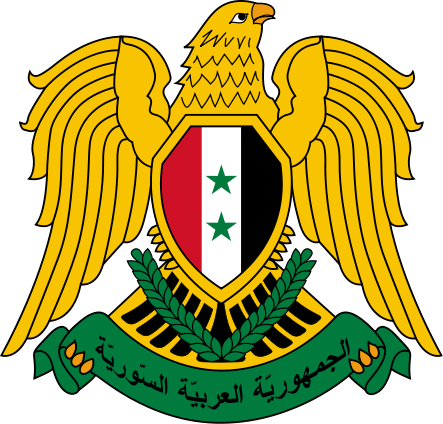 |
|
|
3300 BC - 1200 BC
Mostly part of the Egyptian Empire.
1200 BC - 724 BC
Local kingdoms (Phoenicians, Canaanites, etc.)
724 BC - 612 BC
Part of the Assyrian Empire.
612 BC - 539 BC
Part of the Babylonian Empire.
539 BC - 332 BC
Part of the Persian Empire.
332 BC Conquered by Macedonia under
Alexander "the Great"
319 BC - 301 BC
Antigonid Kingdom
301 BC - 198 BC
Part of Egypt under Ptolemaic dynasty.
198 BC - 63 BC
Part of the Seleucid Empire.
85 BC - 64 BC
Nabataean rule in Damascus
64 BC - 261 AD
Part of the Roman Empire.
261 AD - 272
Ruled by Palmyra.
272 Roman rule restored.
17 Jan 395 Part of the Byzantine Empire.
529 - 584
Damascus administered by Kingdom of Ghassan.
635 Arab Muslim conquest.
1076 - 1154
Part of the Seljuq Empire
1154 - 1176
Egyptian rule.
1176 - 1260
Various local Ayyubid dynasts in Aleppo, Damascus, Hamath
and Homs.
1260 Part of Mameluke Sultanate.
1260 - 1261
Mongol occupation.
1400 - 1401
Occupied by Tamurlane.
23 Aug 1516 Part of the Ottoman Empire.
Feb 1799 - Jun 1799 French occupy
coastal parts of Syria.
14 Jun 1832 - 1840 Annexed
by Egypt (nominally remains under Ottoman suzerainty)
10 Oct 1840 Direct Ottoman rule restored.
30 Sep 1918 Independence (Syria).
25 Oct 1918 - 21 Nov 1919 British/French occupation, divided into
British southern
zone (Palestine), French zone (Lebanon and coastal Syria),
and an interior Arab state (Syria).
08 Mar 1920 United Kingdom of Syria.
24 Jul 1920 France occupies Damascus and Aleppo.
01 Sep 1920 State of Great Lebanon (part of French Syria).
01 Dec 1920 State of Damascus and State of Aleppo formed (under French
mandate).
28 Jun 1922 Union of Syrian States.
29 Sep 1923 - 01 Jan 1944 Syria a League of Nations Mandate under
France.
01 Jan 1925 State of Syria.
01 Sep 1926 Lebanese Republic made a separate mandate.
11 Jun 1932 Syrian Republic.
07 Jul 1939 France cedes Hatay to Turkey, de facto on 23 Jul 1939
10 Jul 1939 State of Syria.
10 Jun 1940 - 21 Jun 1941 Administration loyal to Vichy France (from
21 Jun 1941,
Free French).
21 Jun 1941 - 15 Apr 1946 Occupied by British and (Free) French
troops.
16 Sep 1941 Syrian Republic.
27 Sep 1941 Independence declared.
01 Jan 1944 Independence partial accepted by France.
17 Apr 1946 Full independence recognized by France.
22 Feb 1958 - 28 Sep 1961 Part of United Arab Republic (under Egypt).
28 Sep 1961 Syrian Arab Republic
10 Jun 1967 Israel occupies the Golan Heights (annexed by Israel 14 Dec
1981).
01 Jan 1972 - 19 Nov 1977 Part of Federation of Arab Republics
(Egypt, Libya and Syria)
14 Oct 2008 Syria recognizes Lebanon's sovereignty, establishing
diplomatic relations. |
|
|
|
Territorial Disputes:
Golan Heights is Israeli-occupied with the almost
1,000-strong UN Disengagement Observer Force (UNDOF) patrolling a buffer zone
since 1964; lacking a treaty or other documentation describing the boundary,
portions of the Lebanon-Syria boundary are unclear with several sections in
dispute; since 2000, Lebanon has claimed Shaba'a farms in the Golan Heights;
2004 Agreement and pending demarcation settles border dispute with Jordan;
approximately two million Iraqis have fled the conflict in Iraq with the
majority taking refuge in Syria and Jordan. |
|
|
|
|
- CAANANITE
- Uz ben Shem (possibly
apocryphal)..............................c. 2500 BCE
- Unknown rulers
- Biryawaza......................................................mid
1300's
- Unknown rulers
- URKESH
- A city situated at the base of the Taurus
Mountains in what is now northern Syria near the modern city of Qamishli. It
was founded during the fourth millennium BCE (possibly by the Hurrians) on a
site which appears to have been inhabited before then on a small scale for
centuries: at least since 5000 BCE, the date of the earliest known remains
found there.
- Tupkish-endan.................................................fl.
c. 2250 BCE
- Tar'am-Agade, the daughter of the Sargonid
Akkadian king Naram-Sin, married a king of Urkesh, possibly Tupkish-endan.
- Tish-atal-endan ?
- Shatar-mat ?
- Atal-shen ?
-
Ann-atal.....................................................fl. c. 2050
- Unknown rulers
- Te'irru......................................................fl.
c. 1800
- To Mari thereafter and abandoned c. 1500 BCE.
- Ayab (at
Arvad)..............................................1400's
- Arvad is a Phoenician city located on a tiny
island off the Syrian coast, about equidistant between Tripoli, Lebanon, and
Latakia, Syria. The nearest mainland port is Tartus, which is built on the
ruins of the Arvadite colony of the same name (called Antaradus by the
Greeks). The city was independent from 2nd Millenium to c. 1100.
- ALEPPO
(Kingdom of Yamkhad)
- An ancient city in northwestern Syria, about 80
miles (130 km.) east of Antioch. A kingdom of Yamkhad was established with
Aleppo its capital.
- Yarimlim
I...................................................fl. c. 1800
- Hammurabi I
- Abbael I
- Yarimlim II
- Niqmiepu' I
- Irkabtum
- Hammurabi II
- Yarimlim III
- Abbael II
- Ilimilimma I
- Idrimi.......................................................fl.
c. 1550/00
- Niqmiepu' II
- Ilimilimma
II................................................fl. c. 1450
- The Hittites
control over Aleppo..............c. 1400 - c. 1200
- Telipinu (son
of Suppiliuliumas of Hittites)......mid
- early 1300's
- Talmi-Sharruma..........................................fl.
c. 1330
- Rimisharina.............................................fl.
mid 1200's
- UGARIT (modern Latakia)
- An ancient city-state near Latakia on the Syrian
coast. Its ruins are located in a debris hill (tel) about half a mile from
the shore at Ra's Shamrah. Ugarit was a major center of ancient civilization
which developed an early cuneiform script. Its inhabitants, people of north
Canaanite stock, were major traders who were influenced by and influenced
Sumerian, Minoan, Mycenaean, Hurrian, Hittite, Akkadian and Egyptian
civilization. Several of the Kings of Ugarit are known from a single badly
damaged tablet called KTU 1.113 by archeologists. The sequence and exact
dating of these rulers is uncertain at best. The modern city dates from
about 300 BCE.
- Niqmaddu
I...................................................fl. c. 1850
- Yaqarum......................................................fl.
c. 1825
- Under Egypt c. 1800's - 1600's and then under the
Hyksos 1600's - 1500's.
- Ibiranu
I...............................................fl. 1600's
- Probably under Egypt in 1400's with unknown rulers.
- Ammishtamru
I.......................................1390's - c. 1360
- Niqmaddu
II........................................c. 1360 - c. 1330
- Arhalbu............................................c.
1330 - c. 1324
- Niqmepa............................................c.
1324 - c. 1274
- Ammishtamru
II.....................................c. 1274 - c. 1240
- Ibiranu
II.........................................c. 1240 - ?
- Niqmaddu
III............................................ ? - c. 1225
- Ammurapi...........................................c.
1225 - c. 1180
- Yakurum
II.........................................c. 1180 - ?
- Around 1180 the city of Ugarit was destroyed by
the Sea Peoples and was never rebuilt. Neo-Hittite populations in the region
in 12th-10th centuries. It came under Assyria from c. 900 to 609 and later
under Babylon.
- Aramaeans (some
parts).............................c. 1200 - c. 900
- Aleppo under Aramaeans
control during this time.
- Kingdom of Bashan
- An ancient Kingdom based in the rough country just
to the east of the Golan Heights, in southwestern Syria. It's territory and
influence at times reached into the heights themselves. Ammonite and
Canaanite settlement from 1400's BCE. Amorite incursions from 1300's BCE,
leaded the creation of this Kingdom.
- Zirtaya......................................................fl.
c. 1330
- Amawashe.....................................................1300's
- Og the
Amorite.................................late 1200's - early 1100's
- ARAMAEAN
- Rezon
I........................................................fl. c. 950
- Tab-Rimmon
- Bar Haddad
I..........................................c. 914 - c.880
- Bar Haddad
II.........................................c. 880 - c.843
- A second Aramaic Dynasty
- Hazael................................................c.
843 - c. 804
- Bar Haddad
III.................................................fl. c. 796
- Tab-El.........................................................fl. c. 770
- Rezon
II..............................................c. 740 - 732
- Mati'ilu [at
Arpad (Beit Agusi)]...................mid
700's - 743
- Not to be confused with the Phoenician city of
Arvad, Arpad was a minor Aramaean state north of Aleppo. In 743 BCE the
Assyrian king Tiglath-pileser III led an expedition to Syria to fight the
growing power of Urartu. Arpad allied with Urartu against the Assyrians, and
was beseiged for three years. After taking the city, Tiglath-pileser
presided over the extermination of its inhabitants. The city was destroyed
and never repopulated. To Assyria 743 BCE; the district generally within
Aleppo chronology thereafter...
- TEL BARSIP (Bit Adini, Beit Eden,
Barsib)
- An Aramean city-state in Syria, with its capital
at Tel Barsip near modern Tel Ahmar. Bit Adini was situated on a natural
crossing-point of the Euphrates River and was thus a vitally strategic spot
along the trade and military routes from the Levant into Mesopotamia. This
city state was possibly under Hamath till c. 900 BCE.
- Adin............................................................fl.
early 800's
- Akhuni bar Adin.................................................fl.
850's
- To Assyria till 612. The Assyrians made Barsib a
provincial capital, renaming the town Kar-Shulmanu-Ashared. It came under
Babylon from 612.
- Shamshi-ili (bar Gayah?)..........................c.
750 - 740
- UNQI (Patin)
- A kingdom in what is now northern Syria. Its
capital was Calneh, a city whose exact location is unknown.
- Labarna.........................................................fl.
c. 858
- Unattested King ?
- Labarna
II................................................. ? - 831
- Surri the
Usurper.........................................831 - 830
- Sasi the Kurussean
- Tutammu....................................................
? - 738
- Under Assyria from 738 to 612.
- ZIMRU
- A minor Aramean or Akkadian-speaking kingdom in
ancient times, probably in northeastern Syria.
- Markduk-Mudannik.........................................mid
600's followed by...
- Yan'su bar Khanban
- Zimru was taken by Assyria till 612 and then by
Babylon.
- Assyria..................................................732 - 609
- Aleppo under Assyria from
c. 900 BCE.
- Ilu-Ittia (at
Damascus)...................................fl.
700's
- Arvad came under Assyrian rule from c.1100-625.
Some known rulers of Arvad ruled as Assyrian vassal.
- ARVAD
- Milkuli...................................................fl.
860's
- Matan Baal
I..............................................fl. 850's
- Mut-baal (probably same as
above).........................c. 850's
- Abdiliti..................................................fl.
c. 740
- Avd Ilihit (probably same as
above).......................fl. c. 701
- Matan Baal
II.............................................680's
- Ikkilu....................................................660's
?
- Iakinlu...................................................c.
650's
- Abimilki ben Iakinlu......................................640's
? with...
- Ahimilki ben Iakinlu......................................640's
?
- Azibaal (at
Arvad).............................................to
604 ?
- Babylon..................................................609 - 539
- Arvad under babylon from
604.
- Persia..............,....................................539 - 332
- Strato (at Arvad).........................................330's
- Gerostratos (at
Arvad)....................................c. 330's
- Macedon..................................................332 - 323
- The Kingdom of
Antigonus.................................323 - 301
- Egypt....................................................301 - 198
- The Seleucid
Empire......................................198 - 167
- Abilene was took over by
Ituraea in 85 to 35 BCE and then remained independent till 2nd century CE.
- Arvad remained under
Seleucid Empire till 68 BCE and later under Roman Republic.
- Aleppo under Seleucid
Empire from 301 - c. 80 BCE.
- Ugarit under Seleucid
Empire from 301 - 83 BCE. Briefly it came under Egypt control in 145 BCE.
- Ituraea..................................................167 - 110
- A member of the
Dekapolis................................110 - 85
- Nabataea..................................................85 - 64
- Armenia (some
part)....................................c. 80 - 66
- Aleppo under Armenia c.
80-66 BCE.
- Ugarit (Latakia) under
Armenia 83-73 BCE and then back to Seleucid Empire 73-64 BCE. It came under
Armenia 63-27 BCE.
- The Roman
Republic........................................64 - 27
- Independent
city-state of Beroea 66-64 BCE
- Strato (as
tyrant of Beroea)...................................c.
fl. c. 65 BCE
- Dionysios son of
Heraklion (tyrant
of Beroea)..................fl.
c. 64 BCE
- The Roman
Empire......................................27 BCE - 395 CE
- Ugarit (Latakia) came
under Persian control in 260-261 CE.
- Lysanias (at
Abilene)..........................................fl.
20's CE
- Lysanias should not be
confused with the ruler of Iturea of the same name, but is believed to be a
descendent of that ruler. He is mentioned as reigning during the ministry of
John the Baptist. Abilene is an ancient kingdom north of Iturea, in modern
Syria. The capital was Abila, often called Abila of Lysanias to
differentiate between it with another city by the same name on the Yarmuk
river just inside northwestern Jordan.
- Palmyra (some
parts).....................................261 - 272
- Ugarit briefly came under
Palmyra control 261-272 CE.
- The Byzantine
Empire.....................................395 - 638
- Ugarit (Latakia)
briefly came under Persia in 540 and again in 611.
- Ghassan..................................................529
- 584
- The Byzantine
Empire.....................................584 - ?
- Ghassan....................................................?
- 635
- Prophet Muhammad's
elected successors....................635 - 661
- Emirs (Governors) for the province of Syria were
appointed from 635-661 and 750-1076.
- Abilene and Arvad under Caliphate till 868 and
afterwards under Egypt.
-
UMAYYAD CALIPHATE
- The Caliphate becomes formally hereditary in the
Ummayad clan, a move unrecognized by adherents to 'Ali, a schism which
defines Sunni (Ummayad) and Shia (Aliid) Islam. Ali was assassinated in 660,
apparently by a Kharijite partisan. Muawiyah marched to Kufa, where he
persuaded a number of Ali's supporters to acclaim him as caliph instead of
Ali's son, Hassan in 661. Following his elevation, Muawiyah moved the
capital of the caliphate to Damascus. After Hassan's mysterious death the
same year in 661, his Iraqi followers wrote to Hassan's brother Hussain
pledging allegiance and proposing to remove Muawiya. However, Hussain
refused, choosing to abide by the treaty between Hassan ibn Ali and Muawiyah,
which could not be broken at that time.
- Sufyenid branch
- Abu Abderrahman
Muawiyah I ibn Abi Sufyen................661 - 06 May 680
- Abu Khalid Yazid I ibn
Muawiyah I........................680 - 683 opposed by...
- Abu Khubayb Abdallah
ibn al-Zubayr (in
Hejaz)............680
- Oct 692 opposing...
Zubayrid control over the holy
sites in Mecca and Medina caused the early Umayyads to seek an alternative
pilgrimage site to prevent the Zubayrids from gaining funds from pilgrims.
Identifying the site of the ancient Temple in Jerusalem with a
little-understood reference in the Qur'an to "the farthest place" (al-Aqsa),
they built a new mosque there, which eventually became known as The Dome of
the Rock.
- Abu Abderrahman
Muawiyah II ibn Yazid I..................683 - 684 and then...
- Marwanid branch
- Abu Abd al-Malik
Marwan I ibn al-Hakam...................684 - 685 and then...
- Abul Walid Abd al-Malik
ibn Marwan.......................685 - 705 opposed by...
- He first defeated the governor of Basra Mosaab Ibn
al-Zubair. Abd al-Malik then appointed one of his most able generals and
administrators who would later change the face of the Umayyad Empire, al-Hajjaj
bin Yousef to march against Abd-Allah ibn al-Zubayr, the governor of Hejaz.
He besieged Makkah with almost 12,000 Syrian troops. Abd-Allah ibn al-Zubayr
with a few loyal followers, including his youngest son, were killed in this
fighting around the Kaaba in October 692.
- The Byzantine and Sassanid Empires relied on money
economies before the Muslim conquest, and that system remained in effect
during the Umayyad period. Pre-existing coins remained in use, but with
phrases from the Quran stamped on them. In addition to this, the Umayyad
government began to mint its own coins in Damascus (which were similar to
pre-existing coins), the first coins minted by a Muslim government in
history. Abd
al-Malik ibn Marwan ordered Al-Hajjaj
to mint the first silver Dirhams in 75 AH (694 CE), the first standard
gold Dinar were minted in the following year in 77 AH (676 CE). In the next
years these coins were minted in all the regions of Islam.
- Abu Nu'ama Qatari ibn
al-Fuja'a at-Tamimi (Kharijite,
in Iraq)..688 - 698
and also...
- Atiya ibn al-Aswad (Kharijite,
in Kerman)................690 - 696
- Abul-Abbas Walid I ibn
Abd al-Malik......................705 - 715
- In the year 712, Muhammad
bin Qasim, an Umayyad general sailed from the khaleej into Sindh in India
and conquered both the Sindh and the Punjab regions along the Indus river.
The conquest of Sindh and Punjab, in modern day Pakistan, although costly,
were major gains for the Umayyad Caliphate. However, further gains were
halted by Hindu Kingdoms in North India in the battle of Rajasthan.
- Abu Ayyub Suleyman ibn
Abd al-Malik......................715 - 717
- Abu Hafs Umar II ibn
Abd al-Aziz ibn Marwan..............717 - 720
- Abu Khalid Yazid II
ibn Abd al-Malik.....................720 - 724
- Abul Walid Hisham ibn
Abd al-Malik.......................724 - 743
- Abul-Abbas al-Walid II
ibn Yazid.........................743 - 744
- Abu Khalid Yazid III
ibn al-Walid..............................744
- Abu Ishaq Ibrahim ibn
al-Walid.................................744
- Abu Abd al-Malik
Marwan II ibn Muhammad ibn Marwan.......744 - 750
- The Battle of the Zab took
place on the banks of the Great Zab river in what is now Iraq on January 25,
750. It spelled the end of the Umayyad Caliphate and the rise of the
Abbasids by Abu al-Abbas Abdullah ibn Muhammad as-Saffah.
|
|
|
|
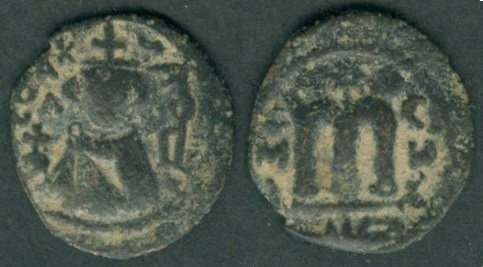 |
MM#10
Copper Follis. Year:
635-700 CE.
Weight: 3.81g.
Metal: Copper.
Diameter:
21.00 mm. Edge:
Plain.
Alignment: Coin.
Mint: Emesa
(now known as Homs).
Obverse: Bust of
a imaginary King with cross above his head. "بحمص" or "الحمص" (Emesa)
written at the right side. Reverse:
Rounded "M" in the center with "EMI" written
on the left and "CHC" written on the right.
Mintage:
N/A.
Minted Years:
635-700 CE.
Ruler:
N/A. Note:
Various minor varieties exists. |
|
 |
SA#125
1 Dinar. Year:
AH 79 (698 CE).
Weight: 4.27g [4.25g].
Metal: 0.916
Gold. Diameter:
20.25 mm. Edge:
Plain.
Alignment: Coin.
Mint: N/A.
Mintage:
N/A.
Minted Years:
AH 77-86 (696-705 CE).
Ruler:
Abul Walid Abd al-Malik ibn Marwan. All
gold Dinar and silver Dirhmas of this ruler are considered Common Type,
however the first three years are sold at higher prices. |
|
Obverse: لا اله الا الله وحده لا شرك له
(There is no diety except (the one) Allah
alone. He has no equal) written in the center. محمد رسول الله
أرسله بالهدى ودين الحق ليظهره على الدين كله
[Muhammad is the messenger of God. Allah sent him with guidance and the
true religion to reveal it to all religions] written in outer
anti-clockwise circle. Reverse:
الله احد الله الصمد لم يلد و لم يولد [Allah
the One and Only; Allah the Eternal Absolute (independent of all, while
all are dependent on Him); He begets not, and neither is He begotten]
written in the center.
بسم الله ضرب هذا الدينر في سنة تسع وسبعين [In
The Name of Allah, this dinar was struck in the year nine and seventy
(79)] written in outer anti-clockwise circle.
Note: All coins dated AH 77-86 are
conventionally ascribed to this ruler. The gold Dinar of AH 77 is
considered the first Islamic coin and held in great esteem. Sales
records reached $400,000 of this coin in 1980s, but latest auction
results have been at about half that amount. |
|
 |
SA#137. Dirham.
Year: AH 123 (741 CE).
Weight: 2.94g. Metal:
Silver. Diameter:
25.50 mm. Alignment:
Medal; but rotated as shown. Edge:
Plain. Mint:
Wasit (Iraq).
Ruler: Abul
Walid Hisham ibn Abd al-Malik. Minted Years:
AH 106 - 125 (724 - 743 CE). Abundant Type. |
Obverse: لا اله الا الله وحده لا شرك له
(There is no diety except (the one) Allah
alone. He has no equal) written in the center.
بسم الله ضرب هذا الدرهم بواسط سنة ثلث و عشرين و مئة
[In The Name of Allah. This dirham was struck
in the year three and twenty and one hundred
(123)] written in outer anti-clockwise circle.Reverse:
الله احد الله الصمد لم يلد و لم يولد و لم يكن له كفوا احد
[Allah the One and Only; Allah the Eternal Absolute (independent of
all, while all are dependent on Him); He begets not, and neither is He
begotten; and there is nothing that could be compared with Him] written
in the center.
محمد رسول الله ارسله بالهدى و دين الحق ليظهره على الدين كله ولو
كره المشركون
[Muhammad is the messenger of God. Allah sent him with guidance and
the true religion to reveal it to all religions even if the polytheists
abhor it] written in outer anti-clockwise circle.
Note: All gold Dinars dated AH 106-125
are conventionally ascribed to this ruler as Common types, except Ifriqiya mint as very rare and al-Andalus mint as
extremely rare. A fractional gold Dinar of Wasit mint of AH 106 is a
modern fake. |
|
 |
SA#140. Dirham.
Year: AH 127 (744 CE).
Weight: 2.67g. Metal:
Silver. Diameter:
24.50 mm. Alignment:
Medal. Edge:
Plain. Mint:
Wasit (Iraq).
Ruler: Abu Ishaq Ibrahim ibn al-Walid.
Minted Years:
AH 126 - 127 (744 CE).
Scarce Type, having 7 annulets around. |
Obverse: لا اله الا الله وحده لا شرك له
(There is no diety except (the one) Allah
alone. He has no equal) written in the center.
بسم الله ضرب هذا الدرهم بواسط سنة سبع و عشرين و مئة
[In The Name of Allah. This dirham was struck
in the year seven and twenty and one hundred
(127)] written in outer anti-clockwise circle.Reverse:
الله احد الله الصمد لم يلد و لم يولد و لم يكن له كفوا احد
[Allah the One and Only; Allah the Eternal Absolute (independent of
all, while all are dependent on Him); He begets not, and neither is He
begotten; and there is nothing that could be compared with Him] written
in the center.
محمد رسول الله ارسله بالهدى و دين الحق ليظهره على الدين كله ولو
كره المشركون
[Muhammad is the messenger of God. Allah sent him with guidance and
the true religion to reveal it to all religions even if the polytheists
abhor it] written in outer anti-clockwise circle.
Note: Only the Dirham of Wasit
AH 126 with seven annulets can be confirmed to this ruler. However,
anonymous coins of AH 127 are traditionally assigned to the ruler. No
gold Dinar can be securely assigned to any of the three short reigns of
al-Walid II [AH 125-126 (743 CE)], Yazid III [AH126 (743-744 CE)] and
Ibrahim [AH 126-127 (744 CE)]. Dinars of AH 126 are rare and may belong
to any of the three. Dinars of AH 127 are extremely rare. |
|
|
|
-
Abbasid
Caliphate........................................750 - 877
- Egypt (Tulunid
Dynasty)..................................877 - 905
- Aleppo under Egypt from 868-896.
- The NUSAYRI (ALAWITES)
- The Nusayri are a Shi'ite sect which developed
during the mid 800's. Originally centered in Kufa, Iraq, the sect is now
located almost exclusively in northwestern Syria (especially Latakia) and in
parts of southern Anatolia and northern Lebanon. The term al-Alevi (Alawites)
is a pejorative given them by other Muslims, referring to their veneration
of the Caliph 'Ali which verges on worship. Among their beliefs are that
human souls (which women do not possess) were cast out of heaven by God, who
periodically manifests himself in the physical world to test mankind. Such
manifestations have included Noah, Moses, Mohammed, and especially 'Ali.
Many Zoroastrian, Christian and pagan beliefs have found their way into
Nusayri'ism, including the venaration of angels and saints, and the
observance of Christmas and other non-Muslim holidays. The Nusayri follow
the Twelver Shi'ite succession until the eleventh Imam, al-Hasan al-'Askari,
who was proclaimed to be a manifestation of the Divine by the sect's
founder, ibn Nusayr.
- Muhammad ibn Nusayr
al-Namiri.........................c. 865 - 880's
- Muhammad ibn Djundab................................c.
880's - ?
- Abu Muhammad Abdallah
al-Djunbulani the Gardener...........? - 900
- Abu Abdallah
al-Hussein ibn Hamdan al-Khasibi..........900 ? - 957
- Muhammad ibn Ali al-Djilli...............................957
- 994
- Surur ibn al-Qasim al-Tabarani...........................994
- 1035
- In the 1000's, the Nusayri sect divided up into
clans, of times warring with each other as much as against infidels. They
were often forced underground by orthodox Muslim as well as Shi'ite regimes.
Nonetheless, they eventually became the most economically successful group
in Syria, and today are the dominant sect in that country, including among
their numbers the ruling Assad family, a disproportionately large percentage
of the armed forces' upper echelons, and many cabinet ministers.
- Abbasid
Caliphate........................................905 - 945
- Abilene under Caliphate till 935 and afterwards
under Egypt (initially Ihkshidid Dynasty) from 935-1071. Aleppo under
Caliphate from 896-945.
- Aleppo (some parts)......................................945 - 946
- HAMDANID (in Aleppo)
- Saif ud-Dawlah
Ali.......................................945 - 967
- Sa'ad ud-Dawlah Sharif
I.................................967 - 991
- Sa'id ud-Dawlah Sa'id....................................991
- 1002
- Abu'l-Hassan Ali
II.....................................1002 - 1004
- Abu'l-Ma'ali Sharif
II.........................................1004
- Aleppo under Egypt
1004-1023.
- Egypt (Ikhshidid
Dynasty)................................946 - 968
- The Qarmatians.................................................968
- Egypt (Ikhshidid
Dynasty)................................968 - 969
- Arvad remained under Egypt
from 968-1071.
- Ugarit (Latakia) came under
Byzantine Empire 969-1084, Rum Seljuqs 1084-1086 and The Great Seljuqs
1086-1098. Duing this period Latakia became associated with the Nusayri (Alawite)
movement. Ugarit came under Antioch 1098-1188, Aleppo 1188-1260, Tripoli
1260-1268 and later under Egypt (Mamluqs) from 1268.
- The Fatamid
Caliphate....................................970 - 971
- The Qarmatians.................................................971
- The Fatamid
Caliphate....................................971 - 978
- Qassam at-Turab (at
Damascus)............................978
- 983
- The Fatamid
Caliphate....................................983 - 1076 and
- FATIMIDS
(in Aleppo)
- Abu Muhammad Lulu al-Kabir.........................1004
– 1009
- Murtada al-Dawla
Mansur............................1009 – 1016
- Mubarak al-Dawla
Fatah.............................1016 – 1017
- Fatik Aziz al-Dawla................................1017
– 1023
- MIRDASID (in Aleppo)
- Assad ud Dawlah Salih
ibn Mirdas........................1023 - 1029
- Shibl ud-Dawlah Nasr
ibn Salih..........................1029 - 1037
- Egypt - Fatamid Emir
(Aleppo Governor) 1037-1042
- Anush Tegin Al-Dabzari.............................1037
- 1042
- Mu'izz ud-Dawlah Tamal
ibn Salih (1st time).............1042
- 1057 d. 1062
- Egypt - Fatamid Emir
(Aleppo Governor) 1057-1060
- Al Hassan ibn Mulhem...............................1057
- 1060
- Rashid ud-Dawlah
Mahmud (1st time)......................1060
- 1061 d. 1075
- Mu'izz ud-Dawlah Tamal
ibn Salih (2nd time).............1061
- 1062
- Abu Du'aba Atiyya ibn
Salih (in Rahba
only 1065-1071)...1062
- 1065
- Rashid ud-Dawlah
Mahmud (2nd time)......................1065
- 1075
- Seljuqs (some
parts)....................................1071 - 1124
- Abilene and Arvad under Seljuqs 1071-1124 and
Aleppo 1075-1079
- Jalal ud-Dawlah Nasr (Mirdasid
emir at Aleppo)............1075 - 1076
- Abu'l-Fada'il Sabiq ibn mahmud (Mirdasid
emir at Aleppo)..1076 - 1079
- SELJUQ
- Haleb (Aleppo)
- Mosul (Uqailid)
control over Aleppo.....................1079 - 1085
- The Aquilites
- Sharaf Ud Dawla
Muslim.............................1079 – 1085
- Ibrahim Bin Quraysh................................1085
– 1085
- Al Sharif Bin Al Habiby............................1085
– 1086
- Abu Sa'id Taj ad-Dawla
Tutush I (Damascus
1079-95)......1085
- 1086 d. 1095
- Malik Shah I (Great
Seljuq 1072-1092)...................1086
- 1087 d. 1092
- Qasim ad-Dawla Abu
Said Aq Sunqur al-Hadjib.............1087 - 1094
- In 1094 Tutush I, the ruler of Damascus, accused
Aq Sunqur of treason and had him beheaded. Aq Sunqur al-Hajib was the father
of Zengi, the founder of the Zengid dynasty.
- Tadj ad-Dawla Abu Said
Tutush I (2nd time)..............1094
- 1095
- After Tutush I's death in 1095, his younger son
Duqaq inherited Damascus, causing Duqaq's older brother Radwan to revolt,
splitting their father's realm.
- Fakhr al-Mulk Radwan
ibn Tutush I.......................1095 - 1113
- Tadj ad-Dawla Alp-Arslan
al-Akhras ibn Radwan...........1113 - 1114
- Sultan Shah ibn Radwan..................................1114
- 1123
- Abu'l-Fadl Ibn al-Khashshab (de
facto).............1113 - 1125
- When Radwan died in 1113, ibn al-Khashshab
governed the city in place of his weak children.
- SELJUQ - Dimashq
(Damascus)
- Aziz (Atzis) ibn Abaaq
al-Khwarazmi.....................1076 - 1079
- Tadj ad-Dawla Abu Said
Tutush I (Aleppo
1085-6,94-5)....1079
- 1095
- Abu Nasr Shams al-Muluk
Duqaq I ibn Tutush I............1095 - 08 Jun 1104
- Tutush
II ibn
Duqaq I..........................................1104
- Muhi ad-Din Baqtash............................................1104
- Toghtegin soon overthrew Duqaq's dynasty to
establish the Burid dynasty, which would rule Damascus for the next
half-century.
- Jerusalem (some
parts)..................................1124 - 1244 and
- Abilene under Jerusalem from 1124-1244.
- The Order of the
Templars...............................1124 - 1302
- Arvad until the order of
the templars from 1124 to 1302 and later under Egypt.
- BURID
(in Damascus)
- Saif-ul-Islam Zahir ud-Din
Tughtigin....................1104 - 1128
- Taj ul-Muluk Buri.......................................1128
- 1132
- Shams ul-Muluk
Ismail...................................1132 - 1135
- Shihab ud-Din
Mahmud....................................1135 - 1139
- Jamal ud-Din
Muhammad...................................1139 - 1140
- Mujir ud-Din Abaq.......................................1140
- 1154
- Muin ad-Din Unur (regent)..........................1140
- 1149
- Atabegs of Haleb (Aleppo)
- Lulu....................................................1114 - 1117
- Shams al-Havas
Yariqtash.......................................1117
- ARTUQID
(in Aleppo)
- Ghazi ibn-Artuq................................................1117
- Timurtash ibn al-Ghazi
(1st time).......................1117
- 1118 d. 1125
- Suleyman I ibn
al-Ghazi.................................1118 - 1121
- Suleyman II (usurper)...................................1121
- 1123
- Nur ad-Dawla Balaq (Usurper:
in Kharpert 1100-1120’s)...1123
- 1124
- Timurtash ibn al-Ghazi
(2nd time).......................1124
- 1125
- Aq Sunkur al-Bursuqi (also
in Mosul)....................1125
- 1127
- Masul ibn Aq Sunkur.....................................1127
- 1128
- Aleppo became under Mosul
1128-1146.
- ZANGID (in Aleppo)
- Imad ad-Din Zengi
al-Mansur ibn Aq Sunqur al-Hajib.1128 - 1146
- Mahmud Nur ad-Din ibn
Zengi.............................1146 - 1174
- Ismail as-Salih al-Malik
ibn Nur ad-Din.................1174 - 1181
- Aleppo became under Mosul
1181-1182.
- Masud..............................................1181
- 1182
- Zangi II Imad ud-Din (brother
of Masud).................1182
- 1183
- AYYUBID (in Aleppo)
- az-Zahir Ghazi Abu
Mansur Ghiyath ud-Din I (governor)..........1183
d. 1216
- Third son of Salah ad-Din
Ayyubi.
- al-Adil I Muhammad
Saif Abu-Bakr ad-Din.................1183 - 1186
- Al-Adil was a son of Najm
ad-Din Ayyub, and a younger brother of Salah ad-Din Ayyubi.
- az-Zahir Ghazi Abu
Mansur Ghiyath ud-Din I (2nd
time)...1186 - 08
Oct 1216
- al-Aziz Muhammad
Ghiyath ud-Din II ibn az-Zahir ........1216 - 1236
- al-Nasr II Yusuf Salah
ad-Din...........................1236 - 1259 d. 1260
- He became the Ayyubid ruler
of Aleppo when he was seven years old. His grandmother Daifah Khatun,
daughter of Al-Adil I, was his regent until her death in 1242. He
occupied Damascus in AH 648 AH (1250) and ruled it
till 1260.
- Dayfa Khatun bint al-Adil
Muhammad (fem.,
regent).......1236
- 1242
- al-Muazzam Turan Shah
(in Damascus
1249-1250)...........1259
- 1260
|
|
|
|
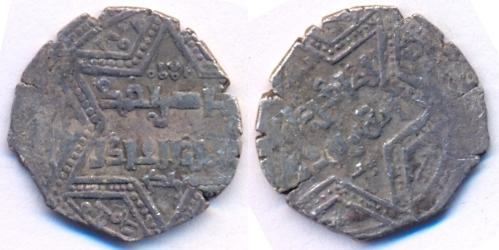 |
SA#836. Dirham.
Year: AH 613-638
(1216-1240 CE).
Weight: 2.63g. Metal:
Silver. Diameter:
20.00 mm. Alignment:
Medal; but rotated as shown. Edge:
Plain. Mint:
Haleb (Aleppo). Abundant Type. Ruler:
Al-Zahir Ghazi Abu Mansur
Ghiyath ud-Duniya wa ud-Din ibn Saladin [governor at Aleppo in
1183], while coins were issued on his name AH 582-613 (1183-1216 CE). |
|
Note: Hexagram type Dirham
with posthumous dates Struck during 613-638. It is identical in style
and alloy to the lifetime Dirhams of al-Zahir Ghazi citing Caliph al-Nasir
and the overload al-Adil Abu Bakr even after their deaths. It is imitative
issue of Crusader Kingdom Tarablus (Tripoli), Lebanon. |
|
 |
SA#842. Dirham.
Year: AH 648
(1250 CE).
Weight: 3.02g. Metal:
Silver. Diameter:
21.00 mm. Alignment:
Medal; but 75% rotated. Edge:
Plain. Mint:
Haleb (Aleppo). Common Type. Ruler:
al-Nasr II Yusuf Salah ad-Din ibn Al-Aziz
Muhammad.
There are numerous subtypes of this coin, some naming a Seljuq or
Ayyubid overload, however this coin is citing Caliph Al Musta'sim B'Allah. |
|
 |
SA#844. Half Dirham.
Year: undated
(1236-1259 CE).
Weight: 1.51g. Metal:
Silver. Diameter:
13.25 x 12.00 mm. Alignment:
almost Coin. Edge:
Plain. Mint:
Acre. Common Type - Crusader imitation. Ruler:
al-Nasr II Yusuf Salah ad-Din ibn Al-Aziz
Muhammad. |
| Note: 1/2
Dirham, various types (normally undated). Some Dirhams and Half Dirhams
of this ruler are now believed to be Crusader imitations, theoretically
distinguished by style, alloy and fabric, occasionally by inscription.
However, the criteria for separating them have not yet been established. |
|
|
|
- Aleppo (Zangid)
rule over Damascus......................1154
- 1174
- Egypt
(Saladin) rule over mainly all Syria..............1174 - 1186
- AYYUBID (in Damascus)
- al-Afdal Ali
Abu'l-Hasan Nur ad-Din ibn Salah ad-Din....1186 - 1196
- al-Adil I Muhammad
Saif ad-Din ibn Najm ad-Din Ayyub....1196
- 1201 d. 1218
- He was also ruler of Egypt 1193-1198
and brother of Salah ad-Din.
- Egypt...................................................1201 - 1218
- Governor
- al-Malik al-Muazzam Isa Sharaf
ad-Din, Emir........1201 - 1218
- al-Muazzam Isa Sharaf
ad-Din ibn al-Adil I (continued)..1218 - 1227
- al-Nasr II Dawud Salah
ad-Din ibn al-Muazzam............1227 - Jun 1229
- He was besieged by the
combined armies of his uncle late in 1228. The siege until June 1229. al-Nasir
later became Emir of Kerak in Transjordan region from 1229-1248. Kerak
was annexed by Egypt in 1249.
- al-Ashraf I Musa
Abu'l-Fath al-Muzaffar ad-Din ibn al-Adil I...1229 - 27 Aug 1237
- al-Salih I Ismail Imad
ad-Din ibn al-Adil I (1st time)..1237
- 1238 d. 1250/1
- al-Kamil I Muhammad
Abu'l-Ma'ali Nasr ad-Din ibn al-Adil I (Eg.
1218-38)...1238
- During his tenure as
sultan, the Ayyubids defeated two crusades. In a temporary agreement with
the Crusaders, he ceded Jerusalem to the Christians.
- al-Adil II Saif ad-Din
ibn al-Kamil I (in Egypt 1238-1240).....1238
- 1239 d. 1248
- al-Salih II Ayyub Najm
ad-Din ibn al-Kamil I (Egypt
1240-1249)........1239
d. 1249
- al-Salih I Ismail Imad
ad-Din ibn al-Adil I (2nd time)..1239
- 1245 d. 1250/1
- al-Salih II Ayyub Najm
ad-Din ibn al-Kamil I (2nd time).1245
- 22 Nov 1249
- al-Muazzam Turan Shah
IV Ghiyath ad-Din ibn al-Salih II.1249 - 1250
- Turanshah was murdered by
the Bahri Mamluks of Egypt, Shajar al-Durr (widow of as-Salih II Ayyub)
seized the throne of Egypt in 1250. al-Nasir Yusuf, being an Ayyubid,
refused to recognize Shajar al-Durr as the Sultana of Egypt.
- al-Nasr II Yusuf Salah
ad-Din ibn al-Aziz (in Aleppo
1236-60)..1250
- 1260
- Tripoli (some
parts)....................................1244 - 1292
- Abilene under Tripoli from 1244-1292.
- The
Mongols.............................................1260 - 1261
- Mameluks at Aleppo
- Imad ud Din Al Qazwinny............................1260
– 1260
- Al Saeed Ali Al Mousily............................1260
– 1260
- Hussam ud Din Lagin................................1260
– 1261
- Egypt...................................................1261 - 1516
- Abilene under Egypt from 1292.
|
- OTTOMAN EMPIRE
- Ottoman Empire......................................Sep
1516 - 1832
- The Ottoman established two
main positions, Walis (Viceroys) of Damascus and Walis of Haleb (Aleppo)
from 1516 to 1918. Walis (Viceroys) of Damascus had broad authority over
most of Lebanon, Jordan, Israel and Syria. Under the Ottomans the wali of
Damascus held the coveted title Amir al Hadj or "Commander of the
Pilgrimage". He took the head of the official caravan which travelled from
Anatolia to Mecca each year and thus bore an extremely important ritual
position within the Ottoman state.
|
|
|
|
Currency: 1 Pound (Lira) = 100 Piastres (Qirsh)
= 4000 para. |
|
 |
KM#65
5 para. Year:
AH 1171 (1757).
Weight: 1.18g [1.20g].
Metal:
Copper. Diameter:
20.50 mm. Edge:
Plain.
Alignment: Rotated.
Mint:
Haleb (Aleppo).
Obverse:
"ضرب في حلب" (Mint at Haleb)
written in the center.
Date at bottom.
Reverse:
Tughra in center.
Mintage:
N/A.
Minted Years:
One year type.
Ottoman Empire Ruler:
Mustafa III AH1171-1187 (1757-1773).
Note:
Krause Publication mentions star above "حلب"
and star at the right side of the Tughra. |
|
|
|
-
Egypt...................................................1832 - 1840
- Technically, Egypt was
still a part of the Ottoman Empire, although as a practical matter it was
entirely autonomous.
- Ottoman
Empire..........................................1840 - 30 Sep 1918
- Head of Government
- Muhammad Said al-Jazairi.......................................30 Sep 1918
- Ali Rida Pasha al-Rikabi.........................30 Sep 1918 - 05 Oct 1918
- Faisal bin Hussein bin
Ali.......................05 Oct 1918 - 08 Mar 1920
- British Commander
-
Edmund Henry Hynman Allenby.................25 Oct 1918 - 21 Nov 1919
- al-Hashemi
- Faisal bin Hussein bin
Ali (continued)...........08
Mar 1920 - 28 Jul 1920
- On 23 October 1916 at Hamra
in the Wadi Safra, the first encounter took place between Faisal and Captain
Thomas Edward Lawrence, a relatively junior British intelligence officer
from Cairo. Lawrence already had a vision of an independent post-war Arabian
state, and knew it was essential to find precisely the right man to lead the
Arab forces to achieve this. Faisal also worked with the Allies during World
War I in their conquest of Greater Syria and the capture of Damascus, where
he became part of a new Arab government in 1918. Faisal was made for a short
time King of the Arab Kingdom of Syria (or Greater Syria) in 1920, and later
he became the King of the Kingdom of Iraq from 1921
to 1933. His rule over Syria ended after only a few months, following
the clash between his Syrian Arab forces and regular French forces at the
Battle of Maysalun. French troops occupied Syria later that year after the
San Remo conference proposed that the League of Nations put Syria under a
French mandate.
- Acting head of State
- Ala ad-Din ad-Durubi Pasha.......................28 Jul 1920 - 21 Aug 1920
- Jamil al-Ulshi...................................06 Sep 1920 - 30 Nov 1920
- France...........................................01 Dec 1920 - 17 Apr 1946
- Governor
- Haqqi Bey al-Azm (State
of Damascus)........01
Dec 1920 - 28 Jun 1922 with...
- Kamil Pasha al-Kudsi (State
of Aleppo)......01
Dec 1920 - 28 Jun 1922
- President
- Subhi Bey Barakat al-Khalidi.....................28
Jun 1922 - 01 Jan 1925
- Head of State
- Subhi Bey Barakat al-Khalidi
(continued).........01
Jan 1925 - 21 Dec 1925
- In 1925, Sultan al-Atrash
led a revolt that broke out in the Druze Mountain and spread to engulf the
whole of Syria and parts of Lebanon. This is considered one of the most
important revolutions against the French mandate, as it encompassed the
whole of Syria and witnessed fierce battles between rebel and French forces.
On August 23, 1925, Sultan Pasha al-Atrash officially declared revolution
against France, and soon fighting erupted in Damascus, Homs and Hama. Al-Atrash
won several battles against the French at the beginning of revolution,
notably the Battle of Al-Kabir on July 21, 1925, the Battle of Al-Mazra'a on
August 2, 1925, and the battles of Salkhad, Almsifarh and Suwayda. After
resistance victories against the French, France sent thousands of troops to
Syria and Lebanon from Morocco and Senegal, equipped with modern weapons;
the rebels were lightly armed. This dramatically altered the results and
allowed the French to regain many cities, although resistance lasted until
the spring of 1927. The French sentenced Sultan al-Atrash to death, but he
had escaped with the rebels to Transjordan and was eventually pardoned. Al-Atrash
strongly rejected the French offer of independence for the Druze Mountain.
He demanded a national Syrian unity.
- Marie François Julien
Pierre-Alype (acting)......09
Feb 1926 - 28 Apr 1926
- Damad-i Shahriyari
Ahmad Nami Bey................28 Apr 1926 - 15 Feb 1928
- Shaykh Taj ad-Din al-Hasani
(acting).............15
Feb 1928 - 19 Nov 1931
-
Léon Solomiac (acting)...........................19
Nov 1931 - 11 Jun 1932
- Presidents
- Muhammad Ali Bey al-Abid.........................11
Jun 1932 - 21 Dec 1936
- Hashim Khalid al-Atassi (1st
time)...............21 Dec 1936 - 07 Jul 1939
- In 1934, France attempted
to impose a treaty of independence heavily prejudiced in favor of France. It
promised gradual independence but kept the Syrian Mountains under French
control. The Syrian head of state at the time was a French puppet, Muhammad
'Ali Bay al-'Abid. Fierce opposition to this treaty was spearheaded by
senior nationalist and parliamentarian Hashim al-Atassi, who called for a
sixty day strike in protest. Atassi's political coalition, the National
Bloc, mobilized massive popular support for his call. Riots and
demonstrations raged, and the economy came to a standstill. The new Popular
Front-led French government then agreed to recognize the National Bloc as
the sole legitimate representatives of the Syrian people and invited Hashim
al-Atassi to independence negotiations in Paris. He traveled there on March
22, 1936, heading a senior Bloc delegation. The resulting treaty called for
immediate recognition of Syrian independence as a sovereign republic, with
full emancipation granted gradually over a 25 year period. The treaty
guaranteed incorporation of previously autonomous Druze and Alawite regions
into Greater Syria, but not Lebanon, with which France signed a similar
treaty in November. The treaty also promised curtailment of French
intervention in Syrian domestic affairs as well as a reduction of French
troops, personnel and military bases in Syria. In return, Syria pledged to
support France in times of war, including the use of its air space, and to
allow France to maintain two military bases on Syrian territory. Other
political, economic and cultural provisions were included. Atassi returned
to Syria in triumph on September 27, 1936 and was later elected President of
the Republic. France ceded the province of Alexandretta (now Hatay), whose
territory was guaranteed as part of Syria in the treaty, to Turkey on 07
July 1939. Riots again broke out, Atassi resigned, and Syrian independence
was deferred until after World War II.
- Nasuhi Salim al-Bukhari (acting).................07
Jul 1939 - 10 Jul 1939
- Chairman Council of
Commissioners/Directors
- Bahij ad-Din al-Khatib...........................10
Jul 1939 - 04 Apr 1941
- Presidents
- Khalid al-Azm (acting)...........................04
Apr 1941 - 16 Sep 1941
- Shaykh Taj ad-Din al-Hasani......................16
Sep 1941 - 17 Jan 1943
- Jamil al-Ulshi (acting)..........................17
Jan 1943 - 25 Mar 1943
- Head of State
- Ata Bey al-Ayyubi................................25
Mar 1943 - 17 Aug 1943
|
|
|
|
French
Mandate/Protectorate coinage of Etat du Syrie (State of Syria) / Republique
Syrienne (Syrian Republic) |
|
|
|
Currency: Livre (Pound) = 100 piastres. |
|
During the period when Syria was a part of Ottoman empire
-which lasted about 400 years- the Turkish lira was the currency. Following the
fall of the Ottoman empire and the placing of Syria under a mandate (French
Occupation), the Egyptian pound was used in the territories under French and
British mandates, including Lebanon, Transjordan, and Palestine. Upon taking
Lebanon and Syria under its separate mandate, the French government sought to
replace the Egyptian currency and granted a commercial bank, the Banque de Syrie
(a French affiliate of the Ottoman Bank), the authority to issue a currency for
states under its new mandate. The pound (or livre as it was then known) was
introduced in 1919 and was pegged at a value of 20 French Francs. As the
political status of Lebanon evolved, the Banque de Syrie, which was to act as
the official bank for Lebanon and Syria, was renamed the Banque de Syrie et du
Grand-Liban (BSL). The BSL issued the Lebanese-Syrian currency for 15 years,
starting in 1924. Two years before the expiration of the 15-year period, the BSL
split the Lebanese-Syrian currency into two separate currencies that could still
be used interchangeably in either state. In 1939, the bank was renamed the
Banque de Syrie et du Liban. |
In 1921, cupro-nickel ½ qirsh coins were
introduced, followed in 1926 by aluminum bronze 2 and 5 qirshan. In
1929, holed, nickel-brass 1 qirsh and silver 10, 25 and 50 qirsha
were introduced. Nickel-brass ½ qirsh were introduced 1935, followed
by zinc 1 qirsh and aluminum-bronze 2½ qirsh in 1940. During the
Second World War, brass 1 qirsh and aluminum 2½ qirsh emergency
coins were issued. These pieces were crudely produced and undated.
Before 1947, the word qirsh was spelled with the initial Arabic
letter غ, after which the word began with ق. In 1941, the peg to the
French franc was replaced by a peg to the British pound of 8.83125
Syrian Pounds = 1 British pound, as a consequence of the occupation
of Syria by British and Free French forces. This rate was based on
the pre-war conversion rate between the Franc and Sterling. In 1946,
following devaluation of the Franc, the Syrian Pound was pegged once
again to the Franc at a rate of 1 pound = 54.35 Francs. The Arabic
spelling girsh
(غرش) was used from 1921 to 1941.
|
|
|
|
1921 |
|
|
|
 |
KM#68
½ piastre. Year:
1921.
Weight: 4.06g [4.00g].
Metal:
Copper-Nickel. Diameter:
21.00 mm. Edge:
Plain.
Alignment: Coin.
Mint: Paris with
privy marks.
Obverse:
"BANQUE DE SYRIE" at top.
Value "½ PIASTRE SYRIENNE" within sprigs in center.
Date at bottom.
Reverse:
Value "½
QIRSH SURRI" in center within roped wreath flanked by oat sprigs above
date.
"AL-BANK AL-SURRI" in Arabic at top. Date at bottom. Mintage:
4,000,000.
Minted Years:
One year type. |
|
|
|
|
1926 |
|
|
|
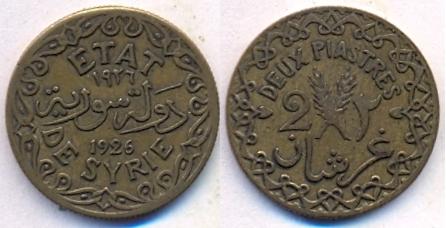 |
KM#69
2 piastres. Year:
1926.
Weight: 1.99g [2.00g].
Metal:
Aluminum-Bronze. Diameter:
18.00 mm. Edge:
Reeded.
Alignment: Coin.
Mint: N/A - without
privy marks.
Obverse:
"ETAT" at the top with date below it. "DULAT SURRIYA" in the
center with date. "DE SYRIE" at the bottom. design at the borders.
Reverse:
"DEUX PIASTRES" at the top. Value in the center with
crossed oat sprigs. "QIRSHAN" written at the bottom.
Mintage:
600,000.
Minted Years:
One year type. |
|
Note:
Krause publication also mentioned
this coin to be produced with Paris privy marks including above mintage,
but never seen. |
|
 |
KM#70
5 piastres. Year:
1926.
Weight: 3.88g [4.00g].
Metal:
Aluminum-Bronze. Diameter:
23.00 mm. Edge:
Reeded.
Alignment: Coin.
Mint: Paris with
privy marks.
Obverse:
"ETAT" at the top with date below it. "DULAT SURRIYA" in the
center with date. "DE SYRIE" at the bottom. design at the borders.
Reverse:
"DEUX PIASTRES" at the top. Value in the center with
crossed oat sprigs. "QIRSHAN" written at the bottom.
Mintage:
300,000.
Minted Years:
1926, 1926 without mint marks, 1933, 1935,
1936 and 1940.
Note:
Paris privy mint marks are seen with below
date. |
|
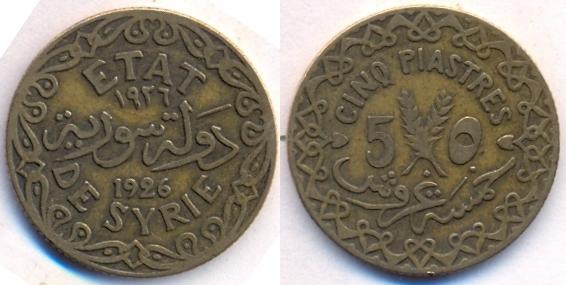 |
Same as above coin but
Mint: N/A - without
privy marks.
Weight: 4.04g [4.00g].
Mintage:
600,000. |
|
|
|
|
1929 |
|
|
|
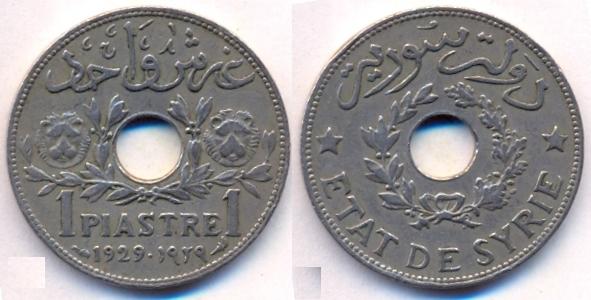 |
KM#71
1 piastre. Year:
1929.
Weight: 4.94g [5.00g].
Metal:
Copper-Nickel. Diameter:
24.00 mm with hole in center. Edge:
Plain.
Alignment: Coin.
Mint: Paris with
privy marks.
Obverse:
"One Piastre" in Arabic at top. Hole in center flanked by lion
heads with value "1 PIASTRE 1" and dates below. Paris privy mark on
both sides of the dates.
Reverse:
""DULAT SURRIYA"
in Arabic at the top.
"ETAT DE SYRIE" in French at bottom.
Wreath around the center hole.
Mintage:
750,000.
Minted Years:
1929, 1933, 1935 and 1936. |
|
 |
KM#72
10 piastres. Year:
1929.
Weight: 1.95g [2.00g].
Metal: 0.680
silver. Diameter:
17.00 mm. Edge:
Reeded.
Alignment: Coin.
Mint:
N/A.
Obverse:
"DULAT SURRIYA" within above banner design. Flower design in the
center. Dates in the below banner design.
Reverse:
"DULAT SURRIYA" at the top.
"10 PIASTRES" written in Arabic and in English in center
circle. "ETAT DE SYRIE" written in below banner design.
Mintage:
1,000,000.
Minted Years:
One year type. |
|
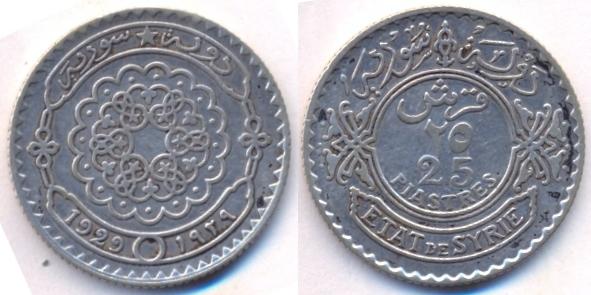 |
KM#73
25 piastres. Year:
1929.
Weight: 4.94g [5.00g].
Metal: 0.680
silver. Diameter:
24.00 mm. Edge:
Reeded.
Alignment: Coin.
Mint:
N/A.
Obverse:
"DULAT SURRIYA" within above banner design. Flower design in the
center. Dates in the below banner design.
Reverse:
"DULAT SURRIYA" at the top. "25 PIASTRES" written in Arabic and in English
in center circle. "ETAT DE SYRIE" written in below banner design.
Mintage:
1,000,000.
Minted Years:
1929 without mint mark, 1933, 1936 and 1937. |
|
 |
KM#74
50 piastres. Year:
1929.
Weight: 9.91g [10.00g].
Metal: 0.680
silver. Diameter:
27.50 mm. Edge:
Reeded.
Alignment: Coin.
Mint:
N/A.
Obverse:
"DULAT SURRIYA" within above banner design. Flower design in the
center. Dates in the below banner design.
Reverse:
"DULAT SURRIYA" at the top. "50 PIASTRES" written in Arabic and in English
in center circle. "ETAT DE SYRIE" written in below banner design.
Mintage:
880,000.
Minted Years:
1929 without mint mark, 1933, 1936 and 1937. |
|
|
|
|
1933 |
|
|
|
 |
KM#71
1 piastre. Year:
1933.
Weight: 4.98g [5.00g].
Metal:
Copper-Nickel. Diameter:
24.00 mm with hole in center. Edge:
Plain.
Alignment: Coin.
Mint: Paris with
privy marks.
Obverse:
"One Piastre" in Arabic at top. Hole in center flanked by lion
heads with value "1 PIASTRE 1" and dates below. Paris privy mark on
both sides of the dates.
Reverse:
""DULAT SURRIYA"
in Arabic at the top.
"ETAT DE SYRIE" in French at bottom.
Wreath around the center hole.
Mintage:
600,000.
Minted Years:
1929, 1933, 1935 and 1936. |
|
 |
KM#70
5 piastres. Year:
1933.
Weight: 3.92g [4.00g].
Metal:
Aluminum-Bronze. Diameter:
23.00 mm. Edge:
Reeded.
Alignment: Coin.
Mint: Paris with
privy marks.
Obverse:
"ETAT" at the top with date below it. "DULAT SURRIYA" in the
center with date. "DE SYRIE" at the bottom. design at the borders.
Reverse:
"DEUX PIASTRES" at the top. Value in the center with
crossed oat sprigs. "QIRSHAN" written at the bottom.
Mintage:
1,200,000.
Minted Years:
1926, 1926 without mint marks, 1933, 1935,
1936 and 1940.
Note:
Paris privy mint marks are on both sides of
ETAT. |
|
 |
Same as above coin but...
Arabic and English last digit "3" in
date is a bit lower then the remaining digits. Secondly the Paris privy
mark on both side are thinner as compared to the above coin.
Weight: 4.02g.
Note:
A third type also exists without Paris privy mint marks
with leveled digits in Date. |
|
 |
KM#73
25 piastres. Year:
1933.
Weight: 4.91g [5.00g].
Metal: 0.680
silver. Diameter:
24.00 mm. Edge:
Reeded.
Alignment: Coin.
Mint: Paris with
privy marks.
Obverse:
"DULAT SURRIYA" within above banner design. Flower design in the
center. Dates and Paris privy
mint marks in the below banner design.
Reverse:
"DULAT SURRIYA" at the top. "25 PIASTRES" written in Arabic and in English
in center circle. "ETAT DE SYRIE" written in below banner design.
Mintage:
500,000.
Minted Years:
1929 without mint mark, 1933, 1936 and 1937. |
|
 |
KM#74
50 piastres. Year:
1933.
Weight: 9.87g [10.00g].
Metal: 0.680
silver. Diameter:
27.50 mm. Edge:
Reeded.
Alignment: Coin.
Mint: Paris with
privy marks.
Obverse:
"DULAT SURRIYA" within above banner design. Flower design in the
center. Dates in the below banner design.
Reverse:
"DULAT SURRIYA" at the top. "50 PIASTRES" written in Arabic and in English
in center circle. "ETAT DE SYRIE" written in below banner design.
Mintage:
250,000.
Minted Years:
1929 without mint mark, 1933, 1936 and 1937. |
|
 |
Fake coin of the above coin:
The dots are not of the same sizes on both sides of the coin. The Arabic
legends are more thicker on reverse side at the top. The bar on Syria in
Arabic is smaller and of irregular style on obverse side. The star is fat as
compared to other issues. The mint mark on the right side of the date is
slightly larger. The edge is irregular. Reeded (lines on the thickness)
is not straight. Slightly smaller in size. Yellowish color on the edge
indicating other metals added. Weights 8.52g instead of usual 9.90-10.00
grams. The digits "33" in both dates are clumsy. |
|
|
|
|
1935 |
|
|
|
 |
KM#75
½ piastre. Year:
1935.
Weight: 3.98g [4.00g].
Metal:
Copper-Nickel. Diameter:
21.00 mm. Edge:
Plain.
Alignment: Coin.
Mint: Paris with
privy marks.
Obverse:
"REPUBLIQUE SYRIENNE" at the top.
Value "½ PIASTRE" in the center. Sprigs
on both sides.
Date at bottom.
Reverse:
"AL-JUMURRIYYA AL-SURRIYA" at the top.
Value "½" in center within roped wreath.
"NISF QIRSH" below the center circle and
date at the bottom. Mintage:
600,000.
Minted Years:
1935 and 1936. |
|
 |
KM#71
1 piastre. Year:
1935.
Weight: 4.91g [5.00g].
Metal:
Copper-Nickel. Diameter:
24.00 mm with hole in center. Edge:
Plain.
Alignment: Coin.
Mint: Paris with
privy marks.
Obverse:
"One Piastre" in Arabic at top. Hole in center flanked by lion
heads with value "1 PIASTRE 1" and dates below. Paris privy mark on
both sides of the dates.
Reverse:
""DULAT SURRIYA"
in Arabic at the top.
"ETAT DE SYRIE" in French at bottom.
Wreath around the center hole.
Mintage:
1,900,000.
Minted Years:
1929, 1933, 1935 and 1936. |
|
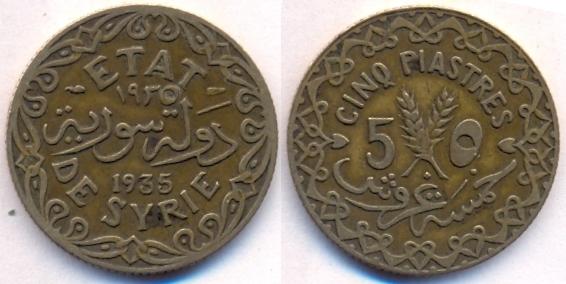 |
KM#70
5 piastres. Year:
1935.
Weight: 4.02g [4.00g].
Metal:
Aluminum-Bronze. Diameter:
23.00 mm. Edge:
Reeded.
Alignment: Coin.
Mint: Paris with
privy marks.
Obverse:
"ETAT" at the top with date below it. "DULAT SURRIYA" in the
center with date. "DE SYRIE" at the bottom. design at the borders.
Reverse:
"DEUX PIASTRES" at the top. Value in the center with
crossed oat sprigs. "QIRSHAN" written at the bottom.
Mintage:
2,000,000.
Minted Years:
1926, 1926 without mint marks, 1933, 1935,
1936 and 1940.
Note:
Paris privy mint marks are on both sides of
ETAT. |
|
|
|
|
1936 |
|
|
|
 |
KM#75
½ piastre. Year:
1935.
Weight: 3.98g [4.00g].
Metal:
Copper-Nickel. Diameter:
21.00 mm. Edge:
Plain.
Alignment: Coin.
Mint: Paris with
privy marks.
Obverse:
"REPUBLIQUE SYRIENNE" at the top.
Value "½ PIASTRE" in the center. Sprigs
on both sides.
Date at bottom.
Reverse:
"AL-JUMURRIYYA AL-SURRIYA" at the top.
Value "½" in center within roped wreath.
"NISF QIRSH" below the center circle and
date at the bottom. Mintage:
800,000.
Minted Years:
1935 and 1936. |
|
 |
KM#71
1 piastre. Year:
1936.
Weight: 5.04g [5.00g].
Metal:
Copper-Nickel. Diameter:
24.00 mm with hole in center. Edge:
Plain.
Alignment: Coin.
Mint: Paris with
privy marks.
Obverse:
"One Piastre" in Arabic at top. Hole in center flanked by lion
heads with value "1 PIASTRE 1" and dates below. Paris privy mark on both sides
of the dates.
Reverse:
""DULAT SURRIYA"
in Arabic at the top.
"ETAT DE SYRIE" in French at bottom.
Wreath around the center hole.
Mintage:
1,400,000.
Minted Years:
1929, 1933, 1935 and 1936. |
|
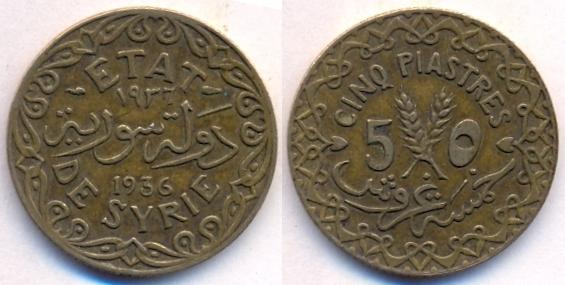 |
KM#70
5 piastres. Year:
1936.
Weight: 4.05g [4.00g].
Metal:
Aluminum-Bronze. Diameter:
23.00 mm. Edge:
Reeded.
Alignment: Coin.
Mint: Paris with
privy marks.
Obverse:
"ETAT" at the top with date below it. "DULAT SURRIYA" in the
center with date. "DE SYRIE" at the bottom. design at the borders.
Reverse:
"DEUX PIASTRES" at the top. Value in the center with
crossed oat sprigs. "QIRSHAN" written at the bottom.
Mintage:
900,000.
Minted Years:
1926, 1926 without mint marks, 1933, 1935,
1936 and 1940.
Note:
Paris privy mint marks are on both sides of
ETAT. |
|
 |
KM#73
25 piastres. Year:
1936.
Weight: 4.98g [5.00g].
Metal: 0.680
silver. Diameter:
24.00 mm. Edge:
Reeded.
Alignment: Coin.
Mint: Paris with
privy marks.
Obverse:
"DULAT SURRIYA" within above banner design. Flower design in the
center. Dates and Paris privy
mint marks in the below banner design.
Reverse:
"DULAT SURRIYA" at the top. "25 PIASTRES" written in Arabic and in English
in center circle. "ETAT DE SYRIE" written in below banner design.
Mintage:
897,000.
Minted Years:
1929 without mint mark, 1933, 1936 and 1937. |
|
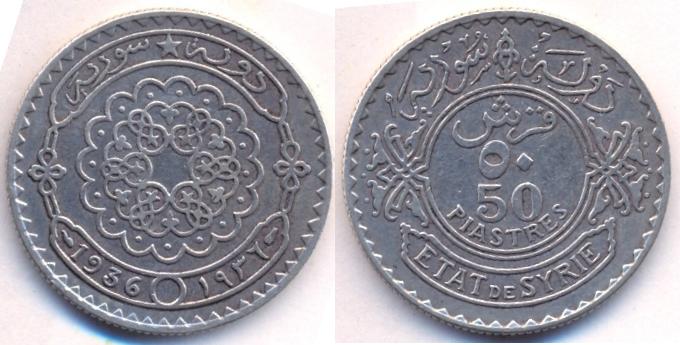 |
KM#74
50 piastres. Year:
1936.
Weight: 9.91g [10.00g].
Metal: 0.680
silver. Diameter:
27.50 mm. Edge:
Reeded.
Alignment: Coin.
Mint: Paris with
privy marks.
Obverse:
"DULAT SURRIYA" within above banner design. Flower design in the
center. Dates in the below banner design.
Reverse:
"DULAT SURRIYA" at the top. "50 PIASTRES" written in Arabic and in English
in center circle. "ETAT DE SYRIE" written in below banner design.
Mintage:
400,000 (including 1937 issue).
Minted Years:
1929 without mint mark, 1933, 1936 and 1937. |
|
|
|
|
1937 |
|
|
|
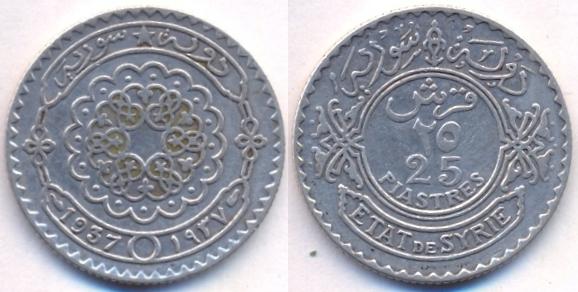 |
KM#73
25 piastres. Year:
1937.
Weight: 4.96g [5.00g].
Metal: 0.680
silver. Diameter:
24.00 mm. Edge:
Reeded.
Alignment: Coin.
Mint: Paris with
privy marks.
Obverse:
"DULAT SURRIYA" within above banner design. Flower design in the
center. Dates and Paris privy
mint marks in the below banner design.
Reverse:
"DULAT SURRIYA" at the top. "25 PIASTRES" written in Arabic and in English
in center circle. "ETAT DE SYRIE" written in below banner design.
Mintage:
393,000.
Minted Years:
1929 without mint mark, 1933, 1936 and 1937. |
|
 |
KM#74
50 piastres. Year:
1937.
Weight: 9.91g [10.00g].
Metal: 0.680
silver. Diameter:
27.50 mm. Edge:
Reeded.
Alignment: Coin.
Mint: Paris with
privy marks.
Obverse:
"DULAT SURRIYA" within above banner design. Flower design in the
center. Dates in the below banner design.
Reverse:
"DULAT SURRIYA" at the top. "50 PIASTRES" written in Arabic and in English
in center circle. "ETAT DE SYRIE" written in below banner design.
Mintage:
400,000 (including 1936 issue).
Minted Years:
1929 without mint mark, 1933, 1936 and 1937. |
|
|
|
|
1940 |
|
|
|
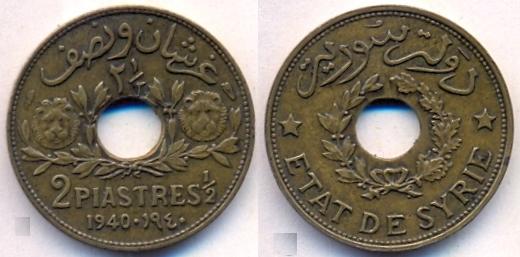 |
KM#76
2½ piastres. Year:
1940.
Weight: 3.00g [3.00g].
Metal:
Aluminum-Bronze. Diameter:
21.00 mm. Edge:
Plain.
Alignment: Coin.
Mint: Paris with
privy marks.
Obverse:
"½ piastres" in Arabic at top.
Hole in center flanked by lion heads with value "2 PIASTRES
½" and dates below.
Privy marks above lion heads.
Reverse:
Wreath around the center hole.
"DULAT SURRIYA"
in Arabic at the top.
"ETAT DE SYRIE" in French at bottom.
Mintage:
2,000,000.
Minted Years:
One year type. |
|
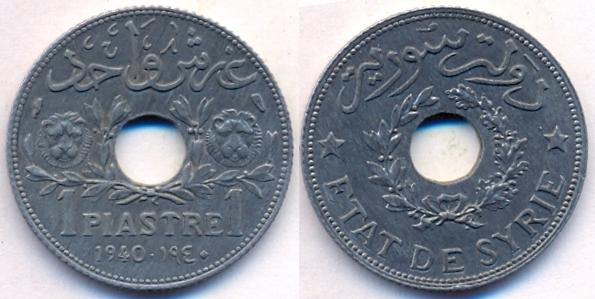 |
KM#71
1 piastre. Year:
1940.
Weight: 3.57g [3.50g].
Metal:
Copper-Nickel. Diameter:
24.25 mm with hole in center. Edge:
Reeded.
Alignment: Coin.
Mint: Paris with
privy marks.
Obverse:
"One Piastre" in Arabic at top. Hole in center flanked by lion
heads with value "1 PIASTRE 1" and dates below. Paris privy mark on both sides,
above lion heads.
Reverse:
"DULAT SURRIYA"
in Arabic at the top.
"ETAT DE SYRIE" in French at bottom.
Wreath around the center hole.
Mintage:
2,000,000.
Minted Years:
One year type. |
|
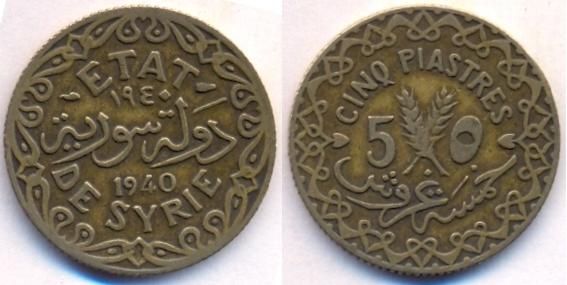 |
KM#70
5 piastres. Year:
1940.
Weight: 4.05g [4.00g].
Metal:
Aluminum-Bronze. Diameter:
23.00 mm. Edge:
Reeded.
Alignment: Coin.
Mint: Paris with
privy marks.
Obverse:
"ETAT" at the top with date below it. "DULAT SURRIYA" in the
center with date. "DE SYRIE" at the bottom. design at the borders.
Reverse:
"DEUX PIASTRES" at the top. Value in the center with
crossed oat sprigs. "QIRSHAN" written at the bottom.
Mintage:
500,000.
Minted Years:
1926, 1926 without mint marks, 1933, 1935,
1936 and 1940.
Note:
Paris privy mint marks are on both sides of
ETAT. |
|
|
|
|
ND (1941) - World War II Coinage |
|
|
|
 |
KM#77 1 piastre. Year:
ND (1941).
Weight: 2.64g.
Metal: Brass.
Diameter:
17.50 mm. Edge:
Plain.
Alignment: Rotated.
Mint: N/A.
Obverse:
"SYRIE" at top.
Numeric value "1" in the center.
"PIASTRE" at the bottom.
Reverse:
"SURRIYA" in arabic at top.
Numeric value "1" in the center.
"PIASTRE" in Arabic at the bottom. Mintage:
N/A.
Minted Years:
One year type. |
|
 |
Same as above coin but...
Arabic numeric "1" is smaller and thicker in size.
Weight: 2.65g. |
|
 |
Same as above coin but...
Smaller size of "غ". Arabic numeric "1" is
slightly larger than above coin. Weight:
2.54g. The world "SYRIE" is thicker. The
word "PIASTRE" alphabets are increasing from left to right. |
|
 |
Same as above coin but...
Weight: 2.67g. The
world "SYRIE" alphabets have irregular sizes. The word "PIASTRE"
alphabets are increasing from left to right.
Interestingly the "ش" has one dot above and two dots below.
Some coin collectors like Patrick Raffin assume that ∴ (upside
triangle) were produced in Damascus and ∵ (downside triangle) in Aleppo
(Halab). |
|
 |
KM#78
2½ piastres. Year:
ND (1941).
Weight: 1.29g.
Metal: Aluminum.
Diameter:
17.75 mm. Edge:
Plain.
Alignment: Rotated.
Mint: N/A.
Obverse:
"SYRIE" at top.
Numeric value "2½" in the center.
"PIASTRE" at the bottom.
Reverse:
"SURRIYA" in arabic at top.
Numeric value "2½" in the center.
"PIASTRE" in Arabic at the bottom. Mintage:
N/A.
Minted Years:
One year type. Interestingly,
you will notice a line on the edge (thickness) of the coin. It indicates
that both sides are glued together and sometimes both sides are of
different sizes. |
|
 |
Same as above coin but...
It has thinner legends on both sides.
Weight: 1.31g.
Alignment: Medal.
|
|
|
|
|
|
- Presidents
- Shukri al-Kuwatli (1st
time).....................17
Aug 1943 - 30 Mar 1949
- Husni az-Zaim....................................30
Mar 1949 - 14 Aug 1949
- Chairman Supreme Military Council
- Sami al-Hinnawi..................................14
Aug 1949 - 15 Aug 1949
- Head of State
- Hashim Khalid al-Atassi
(2nd time)...............15
Aug 1949 - 02 Dec 1951
- Chairman Supreme Military Council
- Adib al-Shishakli (1st
time).....................02
Dec 1951 - 03 Dec 1951
- Head of State
- Fawzi as-Silu....................................03
Dec 1951 - 11 Jul 1953
- Presidents
- Adib al-Shishakli (2nd
time).....................11
Jul 1953 - 25 Feb 1954
- Maamun al-Kuzbari (1st
time - acting)............26
Feb 1954 - 28 Feb 1954
- Hashim Khalid al-Atassi
(3rd time)...............28
Feb 1954 - 06 Sep 1955
- Shukri al-Kuwatli (2nd
time).....................06
Sep 1955 - 22 Feb 1958
- United Arab Republics - Personal union with Egypt
- Gamal Abdel Nasser (Pres. of Egypt
1954-1970)....22 Feb 1958 - 29 Sep 1961
- Beginning in 1957, Syria
was close to a communist takeover of political power; it had a highly
organized Communist Party and the army's chief of staff, Afif al-Bizri, was
a Communist sympathizer. Egyptian president Gamal Abdel Nasser told a Syrian
delegation, including President Shukri al-Kuwatli and Prime Minister Khaled
al-Azem, that they needed to rid their government of communists, but the
delegation countered and warned him that only total union with Egypt would
end the "communist threat". According to Abdel Latif Boghdadi, Nasser
resisted a total union with Syria, favoring instead a federal union.
However, Nasser was "more afraid of a Communist takeover" and agreed on a
total merger. The increasing strength of the Syrian Communist Party, under
the leadership of Khalid Bakdash, worried the ruling Ba'ath Party (Ba'ath
Party founders Michel Aflaq and Salah al-Din al-Bitar), which was also
suffering from an internal crisis from which prominent members were anxious
to find an escape. Syria had had a democratic government since the overthrow
of Adib al-Shishakli's military regime in 1954, and popular pressure for
Arab unity was reflected in the composition of parliament.
- Presidents
- Maamun al-Kuzbari (2nd
time - acting)............29
Sep 1961 - 20 Nov 1961
- Izzat al-Nuss (acting)...........................20
Nov 1961 - 14 Dec 1961
- Nazim al-Kudsi...................................14
Dec 1961 - 08 Mar 1963 with...
- Abdul Karim Zahreddin
(Junta Chief)..............28
Mar 1962 - 13 Apr 1962
- The 08 March Revolution,
also referred to the 1963 March Revolution, was a coup which followed a
successful Ba'athist coup d'état in Iraq. Syrian party’s military committee
succeeded in persuading Nasserist and independent officers to make common
cause with it, and successfully carried out a military coup, overthrowing
Nazim al-Kudsi and installing the Ba'ath party to power. The bloody
revolution resulted in more than 800 killed.
- Chairman National Revolutionary
Command Council
- Louai al-Atassi..................................09
Mar 1963 - 27 Jul 1963
- Muhammad Amin
al-Hafez...........................27 Jul 1963 - 13 May 1964
- Chairman Presidential Council
- Muhammad Amin al-Hafez
(continued)...............13
May 1964 - 23 Feb 1966
- The Syrian coup d'état of
1966 took place on February 23 and was led by neo-Ba'ath Party members
against the country's first Baathist regime. It brought to power Syria's
most radical government and was precipitated by a heightening in the power
struggle between the party's old guard and younger factions. On 21 February,
supporters of the old guard in the army ordered the transfer of their
rivals. Two days later, the Military Committee, backing the younger
factions, launched a coup that involved bloody fighting in Aleppo, Damascus,
Deir ez-Zor, and Latakia. As a result of the coup, the party's historical
founders fled the country and spent the rest of their lives in exile. The
coup also created a permanent schism between the Syrian and Iraqi branches
of the party.
- Head of State
- Nureddin Mustafa al-Atassi.......................25
Feb 1966 - 18 Nov 1970
- Sayyid Ahmed al-Hasan
al-Khatib..................18 Nov 1970 - 22 Feb 1971
- President
- Hafez Ali Sulayman
al-Assad......................22
Feb 1971 - 10 Jun 2000
- Acting from 22 Feb 1971 to 14 Mar 1971. In 1983,
Assad suffered a heart attack and was confined to hospital. He named a
six-man governing council to run the country in his absence, among them
long-time Defense Minister Mustafa Tlass; Hafez-al Assad believed that they
were less likely to try to seize power. Despite this, rumors spread that
Assad was dead or nearly so, and indeed his condition was serious. In 1984,
his brother Rifaat al-Assad attempted to use the security forces under his
control to seize power. His Defense Company troops of some 50,000 men,
complete with tanks and helicopters, began putting up roadblocks throughout
Damascus, and tensions between Hafez loyalists and Rifaat supporters came
close to all-out war. The stand-off was not ended until Hafez, still ill,
rose from his bed to reassume power and speak to the nation. He transferred
command of the Defense Company and, without formal accusations, shortly
afterwards Rifaat was exiled to France.
- Abdul-Halim Khaddam (acting).....................10
Jun 2000 - 17 Jul 2000
- Bashar
al-Assad..................................17 Jul 2000 - date
- On 25 August 2020, President Bashar al-Assad
designates Hussein Arnous to form a new government. On 30 August 2020, his
government is named with Kinan Yaghi as finance minister, the foreign,
defense, and interior ministers remaining in place. On 02 September 2020,
the new government of Prime Minister Hussein Arnous is sworn in.
|
|
|
|
Republic of Syria Coinage |
|
Currency: Livre (Pound) = 100 piastres.
Imperial eagle; Coat of arms of Syria with three stars in the
center. |
|
A new coinage was introduced between 1947 and 1948 in
denominations of 2½, 5, 10, 25 and 50 qirsha and 1 pound, with the 2½, 5 and 10
qirush struck in cupro-nickel and the others in silver. In 1947, the U.S. dollar
was adopted as the peg for the Syrian currency, with 2.19148 pounds = 1 dollar,
a rate which was maintained until 1961. The Lebanese and Syrian currencies split
in 1948. From 1961, a series of official exchange rates were in operation,
alongside a parallel, market rate which diverged dramatically from the official
rate in the 1980s. Aluminum-bronze replaced cupro-nickel in 1960, with nickel replacing silver in 1968. In 1996, following
high inflation, new coins were introduced in denominations of 1, 2, 5, 10 and 25
pounds, with the 25 pounds a bimetallic coin. In 2003 5, 10, and 25 pound coins
were issued, with latent images. After the war, the Arabic spelling was changed from girsh
(غرش) to qirsh (قرش). |
|
|
|
1947 - AH 1366 |
|
|
|
 |
KM#79
25 piastres. Year:
1947 - AH 1366.
Weight: 2.42g [2.50g].
Metal: 0.600
silver. Diameter:
19.50 mm. Edge:
Reeded.
Alignment: Coin.
Mint: N/A.
Obverse:
Value within circle of designed flanked
by oat sprigs. "الجمهورية" السورية" (Al-Jumhūriyyah As-Sūriyyah) written
within the design. Dates below the design.
Reverse:
Imperial eagle; Coat of arms of Syria. Mintage:
6,300,000.
Minted Years:
One year type. |
|
 |
KM#80
50 piastres. Year:
1947 - AH 1366.
Weight: 4.97g [5.00g].
Metal: 0.600
silver. Diameter:
24.00 mm. Edge:
Reeded.
Alignment: Coin.
Mint: N/A.
Obverse:
Value within circle of designed flanked
by oat sprigs. "الجمهورية" السورية" (Al-Jumhūriyyah As-Sūriyyah) written
below the design with dates on both sides.
Reverse:
Imperial eagle; Coat of arms of Syria. Mintage:
4,500,000.
Minted Years:
One year type. |
|
|
|
|
1948 - AH 1367 |
|
|
|
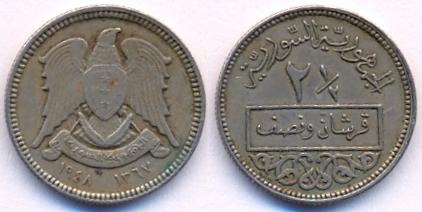 |
KM#81
2½ piastres. Year:
1948 - AH 1367.
Weight: 2.02g [2.00g].
Metal:
Copper-Nickel. Diameter:
17.00 mm. Edge:
Reeded.
Alignment: Medal.
Mint: N/A.
Obverse:
Imperial eagle; Coat of arms of Syria.
Date at the bottom.
Reverse:
"الجمهورية" السورية" (Al-Jumhūriyyah
As-Sūriyyah) written at the top.
Numeric value "2½" written below it.
Value inscription in Arabic written in the rectangle box. Design at the
bottom. Mintage:
2,500,000.
Minted Years:
1948-AH1367 and 1956-AH1375. |
|
 |
KM#82
5 piastres. Year:
1948 - AH 1367.
Weight: 2.99g [3.00g].
Metal:
Copper-Nickel. Diameter:
19.00 mm. Edge:
Reeded.
Alignment: Medal.
Mint: N/A.
Obverse:
Imperial eagle; Coat of arms of Syria.
Date at the bottom.
Reverse:
Value within
diamond shape above design. "الجمهورية" السورية" (Al-Jumhūriyyah
As-Sūriyyah) written at the bottom.
One star on each side. Mintage:
8,000,000.
Minted Years:
1948-AH1367 and 1956-AH1375. |
|
 |
KM#83
10 piastres. Year:
1948 - AH 1367.
Weight: 4.02g [4.00g].
Metal:
Copper-Nickel. Diameter:
21.00 mm. Edge:
Reeded.
Alignment: Medal.
Mint: N/A.
Obverse:
Imperial eagle; Coat of arms of Syria.
Date at the bottom.
Reverse:
"الجمهورية" السورية" (Al-Jumhūriyyah
As-Sūriyyah) written at the top.
Value in the center surrounded by three sided
design. Mintage:
N/A.
Minted Years:
1948-AH1367 and 1956-AH1375. |
|
|
|
|
1950 - AH 1369 |
|
|
|
 |
KM#85
1 Lira (Pound). Year:
1950 - AH 1369.
Weight: 9.96g [10.00g].
Metal: 0.600
silver. Diameter:
27.50 mm. Edge:
Reeded.
Alignment: Coin.
Mint: N/A.
Obverse:
Imperial eagle; Coat of arms of Syria.
Date at the bottom.
Reverse:
"الجمهورية" السورية" (Al-Jumhūriyyah
As-Sūriyyah) written at the top.
Inscription and value within center of
rectangle and sprigs
design. Mintage:
7,000,000.
Minted Years:
One year type. |
Two gold coins were also produced this year with the
following details.
- KM#84
½ Pound.
Weight: 3.3793g.
Metal: 0.900
Gold.
Mintage:
100,000.
- KM#86 1 Pound.
Weight: 6.7586g.
Metal: 0.900
Gold.
Mintage:
250,000.
|
|
|
|
|
1956 - AH 1375 |
|
|
|
 |
KM#81
2½ piastres. Year:
1956 - AH 1375.
Weight: 2.02g [2.00g].
Metal:
Copper-Nickel. Diameter:
17.00 mm. Edge:
Reeded.
Alignment: Medal.
Mint: N/A.
Obverse:
Imperial eagle; Coat of arms of Syria.
Date at the bottom.
Reverse:
"الجمهورية" السورية" (Al-Jumhūriyyah
As-Sūriyyah) written at the top.
Numeric value "2½" written below it.
Value inscription in Arabic written in the rectangle box. Design at the
bottom. Mintage:
5,000,000.
Minted Years:
1948-AH1367 and 1956-AH1375. |
|
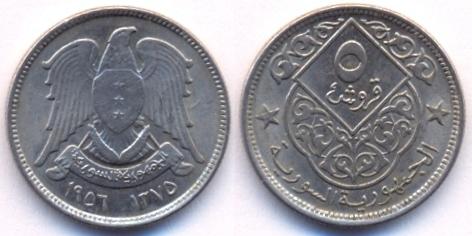 |
KM#82
5 piastres. Year:
1956 - AH 1375.
Weight: 3.01g [3.00g].
Metal:
Copper-Nickel. Diameter:
19.00 mm. Edge:
Reeded.
Alignment: Medal.
Mint: N/A.
Obverse:
Imperial eagle; Coat of arms of Syria.
Date at the bottom.
Reverse:
Value within
diamond shape above design. "الجمهورية" السورية" (Al-Jumhūriyyah
As-Sūriyyah) written at the bottom.
One star on each side. Mintage:
4,000,000.
Minted Years:
1948-AH1367 and 1956-AH1375. |
|
 |
KM#83
10 piastres. Year:
1956 - AH 1375.
Weight: 3.97g [4.00g].
Metal:
Copper-Nickel. Diameter:
21.00 mm. Edge:
Reeded.
Alignment: Medal.
Mint: N/A.
Obverse:
Imperial eagle; Coat of arms of Syria.
Date at the bottom.
Reverse:
"الجمهورية" السورية" (Al-Jumhūriyyah
As-Sūriyyah) written at the top.
Value in the center surrounded by three sided
design. Mintage:
4,000,000.
Minted Years:
1948-AH1367 and 1956-AH1375. |
|
|
|
|
United Arab Republics - Syrian Coinage |
|
Currency: Livre (Pound) = 100 piastres.
Imperial eagle; Coat of arms of Syria with two stars in the
center. |
|
|
|
1958 - AH 1377 |
|
|
|
 |
KM#87
25 piastres. Year:
1958 - AH 1377.
Weight: 2.46g [2.50g].
Metal: 0.600
silver. Diameter:
19.50 mm. Edge:
Reeded.
Alignment: Medal.
Mint: N/A.
Obverse:
"الجمهورية العربية المتحدة"
(Al-Jumhuriyah Al-Arabiyah Al-Muttahidah) written at the top. Dates on
both sides. Value flanked in the center by oat sprigs and mechanical
gear. "Qirsh Surriyah" written in Arabic at the bottom.
Reverse:
Imperial eagle; Coat of arms. Mintage:
2,300,000.
Minted Years:
One year type. |
|
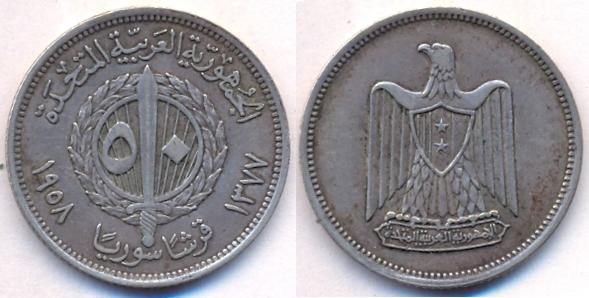 |
KM#88
50 piastres. Year:
1958 - AH 1377.
Weight: 4.96g [5.00g].
Metal: 0.600
silver. Diameter:
24.00 mm. Edge:
Reeded.
Alignment: Medal.
Mint: N/A.
Obverse:
"الجمهورية العربية المتحدة" (Al-Jumhuriyah
Al-Arabiyah Al-Muttahidah) written at the top. Dates on both sides.
Sword divides value within wreath. "Qirsh Surriyah" written in Arabic at
the bottom.
Reverse:
Imperial eagle; Coat of arms. Mintage:
1,200,000.
Minted Years:
One year type. |
|
|
|
|
1959 - AH 1378 |
|
|
|
 |
KM#89
50 piastres. Year:
1959 - AH 1378.
Weight: 5.06g [5.00g].
Metal: 0.600
silver. Diameter:
24.00 mm. Edge:
Reeded.
Alignment: Medal.
Mint: N/A.
Obverse:
"الجمهورية العربية المتحدة" (Al-Jumhuriyah
Al-Arabiyah Al-Muttahidah) written at the top. Dates on both sides.
Value in center with date: 22 February 1958. "Qirsh Surriyah" written in Arabic at
the bottom.
Reverse:
Imperial eagle; Coat of arms. Mintage:
1,500,000.
Minted Years:
One year type.
Subject: First
anniversary, founding of United Arab Republics. |
|
|
|
|
1960 - AH 1380 |
|
|
|
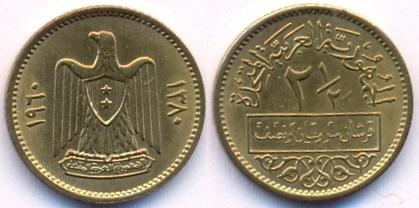 |
KM#90
2½ piastres. Year:
1960 - AH 1380.
Weight: 2.07g [2.00g].
Metal:
Aluminum-Bronze. Diameter:
17.00 mm. Edge:
Reeded.
Alignment: Medal.
Mint: N/A.
Obverse:
Imperial eagle; Coat of arms of Syria.
Date on both sides.
Reverse:
"الجمهورية العربية المتحدة"
(Al-Jumhuriyah
Al-Arabiyah Al-Muttahidah) written at the top.
Numeric value "2½" written below it.
Value inscription in Arabic written in the rectangle box. Design at the
bottom. Mintage:
1,100,000.
Minted Years:
One year type. |
|
 |
KM#91
5 piastres. Year:
1960 - AH 1380.
Weight: 3.02g [3.00g].
Metal:
Aluminum-Bronze. Diameter:
19.00 mm. Edge:
Reeded.
Alignment: Medal.
Mint: N/A.
Obverse:
Imperial eagle; Coat of arms of Syria.
Date on both sides.
Reverse:
"الجمهورية العربية المتحدة"
(Al-Jumhuriyah
Al-Arabiyah Al-Muttahidah) written at the top.
Value within diamond shape
between design.
One star on each side. Mintage:
4,240,000.
Minted Years:
One year type. |
|
 |
KM#92
10 piastres. Year:
1960 - AH 1380.
Weight: 4.06g [4.00g].
Metal:
Aluminum-Bronze. Diameter:
21.00 mm. Edge:
Reeded.
Alignment: Medal.
Mint: N/A.
Obverse:
Imperial eagle; Coat of arms of Syria.
Date on both sides.
Reverse:
"الجمهورية العربية المتحدة"
(Al-Jumhuriyah
Al-Arabiyah Al-Muttahidah) written at the top.
Value in the center surrounded by three sided
design. Mintage:
2,800,000.
Minted Years:
One year type. |
|
|
|
|
Arab Republic of Syria Coinage |
|
Currency: Livre (Pound) = 100 piastres.
Imperial eagle; Coat of arms of Syria with three stars in the
center. |
|
|
|
1962 - AH 1382 |
|
|
|
 |
KM#93
2½ piastres. Year:
1962 - AH 1382.
Weight: 1.96g [2.00g].
Metal:
Aluminum-Bronze. Diameter:
17.00 mm. Edge:
Reeded.
Alignment: Medal.
Mint: N/A.
Obverse:
Imperial eagle; Coat of arms of Syria.
Dates at the bottom.
Reverse:
"الجمهورية العربية السورية" (Al-Jumhūriyyah Al-‘Arabīyah As-Sūriyyah) written at the top.
Numeric value "2½" written below it.
Value inscription in Arabic written in the rectangle box. Design at the
bottom. Mintage:
8,000,000.
Minted Years:
1962-AH1382 and 1965-AH1385. |
|
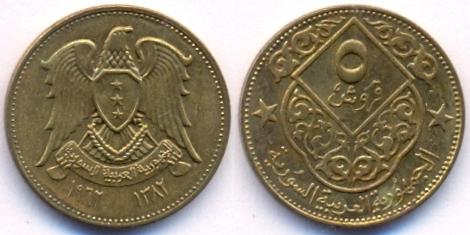 |
KM#94
5 piastres. Year:
1962 - AH 1382.
Weight: 2.97g [3.00g].
Metal:
Aluminum-Bronze. Diameter:
19.00 mm. Edge:
Reeded.
Alignment: Medal.
Mint: N/A.
Obverse:
Imperial eagle; Coat of arms of Syria.
Dates at the bottom.
Reverse:
Value within
diamond shape above design. Star on both sides.
"الجمهورية العربية السورية" (Al-Jumhūriyyah
Al-Arabīyah As-Sūriyyah)
written at the bottom. Mintage:
7,000,000.
Minted Years:
1962-AH1382 and 1965-AH1385. |
|
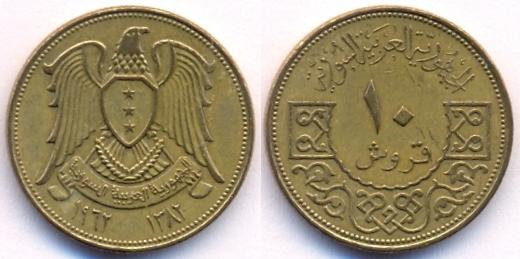 |
KM#95
10 piastres. Year:
1962 - AH 1382.
Weight: 3.99g [4.00g].
Metal:
Aluminum-Bronze. Diameter:
21.00 mm. Edge:
Reeded.
Alignment: Medal.
Mint: N/A.
Obverse:
Imperial eagle; Coat of arms of Syria.
Dates at the bottom.
Reverse:
"الجمهورية العربية السورية" (Al-Jumhūriyyah
Al-Arabīyah As-Sūriyyah) written at the top.
Value in the center surrounded by three sided
design. Mintage:
6,000,000.
Minted Years:
1962-AH1382 and 1965-AH1385. |
|
|
|
|
1965 - AH 1385 |
|
|
|
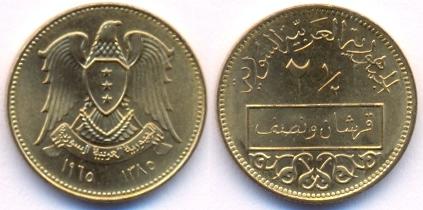 |
KM#93
2½ piastres. Year:
1965 - AH 1385.
Weight: 1.94g [2.00g].
Metal:
Aluminum-Bronze. Diameter:
17.00 mm. Edge:
Reeded.
Alignment: Medal.
Mint: N/A.
Obverse:
Imperial eagle; Coat of arms of Syria.
Dates at the bottom.
Reverse:
"الجمهورية العربية السورية" (Al-Jumhūriyyah
Al-Arabīyah As-Sūriyyah) written at the top.
Numeric value "2½" written below it.
Value inscription in Arabic written in the rectangle box. Design at the
bottom. Mintage:
8,000,000.
Minted Years:
1962-AH1382 and 1965-AH1385. |
|
 |
KM#94
5 piastres. Year:
1965 - AH 1385.
Weight: 2.99g [3.00g].
Metal:
Aluminum-Bronze. Diameter:
19.00 mm. Edge:
Reeded.
Alignment: Medal.
Mint: N/A.
Obverse:
Imperial eagle; Coat of arms of Syria.
Dates at the bottom.
Reverse:
Value within
diamond shape above design. Star on both sides.
"الجمهورية العربية السورية" (Al-Jumhūriyyah
Al-Arabīyah As-Sūriyyah)
written at the bottom. Mintage:
18,000,000.
Minted Years:
1962-AH1382 and 1965-AH1385. |
|
 |
KM#95
10 piastres. Year:
1965 - AH 1385.
Weight: 3.99g [4.00g].
Metal:
Aluminum-Bronze. Diameter:
21.00 mm. Edge:
Reeded.
Alignment: Medal.
Mint: N/A.
Obverse:
Imperial eagle; Coat of arms of Syria.
Dates at the bottom.
Reverse:
"الجمهورية العربية السورية" (Al-Jumhūriyyah
Al-Arabīyah As-Sūriyyah) written at the top.
Value in the center surrounded by three sided
design. Mintage:
22,000,000.
Minted Years:
1962-AH1382 and 1965-AH1385. |
|
 |
Same as above coin but...
Weight: 4.11g [4.00g].
Less segments/reeded
lines on the edge (thickness) of the coin. |
|
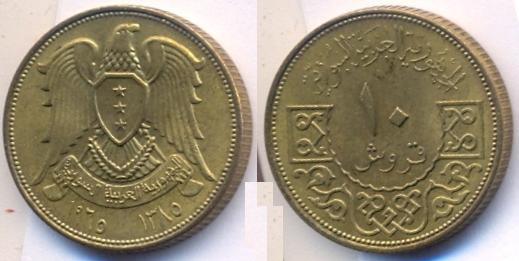 |
Same as above coin but...
Weight: 4.02g [4.00g].
Coarser
segments/reeded lines on
the edge (thickness) of the coin. |
|
|
|
|
1968 - AH 1387 |
|
|
|
 |
KM#96
25 piastres. Year:
1968 - AH 1387.
Weight: 3.38g [3.35g].
Metal:
Nickel. Diameter:
19.75 mm. Edge:
Reeded.
Alignment: Coin.
Mint: N/A.
Obverse:
Value written on top. "الجمهورية العربية السورية" (Al-Jumhūriyyah
Al-Arabīyah As-Sūriyyah) written
within the rectangular box in the center. Dates on
both sides. Design at the bottom.
Reverse:
Imperial eagle; Coat of arms. Mintage:
15,000,000.
Minted Years:
One year type. |
|
 |
KM#97
50 piastres. Year:
1968 - AH 1387.
Weight: 4.87g [5.00g].
Metal:
Nickel. Diameter:
23.75 mm. Edge:
Reeded.
Alignment: Coin.
Mint: N/A.
Obverse:
"الجمهورية العربية السورية" (Al-Jumhūriyyah
Al-Arabīyah As-Sūriyyah) written
at the top. Value within the rectangular box in the center. Dates below
it and wreath at the bottom.
Reverse:
Imperial eagle; Coat of arms. Mintage:
10,000,000.
Minted Years:
One year type. |
|
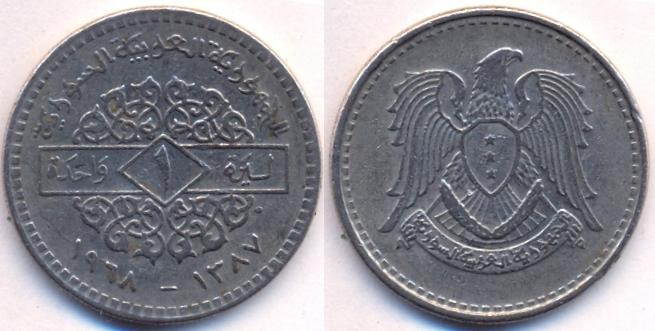 |
KM#98
1 Pound. Year:
1968 - AH 1387.
Weight: 7.54g [7.50g].
Metal:
Nickel. Diameter:
27.00 mm. Edge:
Reeded.
Alignment: Coin.
Mint: N/A.
Obverse:
"الجمهورية العربية السورية" (Al-Jumhūriyyah
Al-Arabīyah As-Sūriyyah) written
at the top. Value in diamond at center of rectangular box in the center. Dates at the
bottom.
Reverse:
Imperial eagle; Coat of arms. Mintage:
10,000,000.
Minted Years:
1968 - AH 1387 and 1971
- AH 1391. |
|
|
|
|
1968 - AH 1388 |
|
|
|
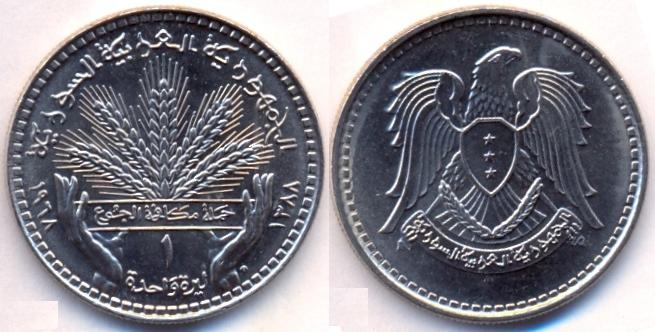 |
KM#99
1 Pound. Year:
1968 - AH 1387.
Weight: 7.49g [7.50g].
Metal:
Nickel. Diameter:
27.00 mm. Edge:
Reeded.
Alignment: Coin.
Mint: N/A.
Obverse:
"الجمهورية العربية السورية" (Al-Jumhūriyyah
Al-Arabīyah As-Sūriyyah) written
at the top. Hands holding rectangle, oats sprigs bouquet above. Dates on
both sides. Value at the bottom.
Reverse:
Imperial eagle; Coat of arms. Mintage:
500,000.
Minted Years:
One year type. |
|
|
|
|
1971 - AH 1391 |
|
|
|
 |
KM#100
5 piastres. Year:
1971 - AH 1391.
Weight: 2.85g [3.00g].
Metal:
Aluminum-Bronze. Diameter:
19.00 mm. Edge:
Reeded.
Alignment: Coin.
Mint: N/A.
Obverse:
Imperial eagle; Coat of arms of Syria.
Dates at the bottom.
Reverse:
Agricultural related
slogan on the top. Value super imposed in the center on upright oat
sprig. Springs at the bottom.
Mintage:
15,000,000.
Minted Years:
One year type. |
|
 |
KM#98
1 Pound. Year:
1971 - AH 1391.
Weight: 7.58g [7.50g].
Metal:
Nickel. Diameter:
27.00 mm. Edge:
Reeded.
Alignment: Coin.
Mint: N/A.
Obverse:
"الجمهورية العربية السورية" (Al-Jumhūriyyah
Al-Arabīyah As-Sūriyyah) written
at the top. Value in diamond at center of rectangular box in the center. Dates at the
bottom.
Reverse:
Imperial eagle; Coat of arms. Mintage:
10,000,000.
Minted Years:
1968 - AH 1387 and 1971
- AH 1391. |
|
|
|
|
1972 - AH 1392
- 25th anniversary of Al-Ba'ath party
issues. |
|
Imperial eagle; Coat of arms of Syria without any star in the
center from 1972 to 1976. |
|
|
|
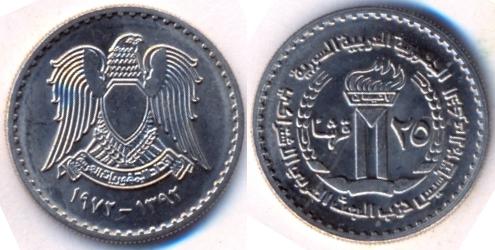 |
KM#101
25 piastres. Year:
1972 - AH 1392.
Weight: 3.29g [3.35g].
Metal:
Nickel. Diameter:
19.75 mm. Edge:
Reeded.
Alignment: Coin.
Mint: N/A.
Obverse:
Imperial eagle; Coat of arms. Dates at the bottom.
Reverse:
"الجمهورية العربية السورية" (Al-Jumhūriyyah
Al-Arabīyah As-Sūriyyah) written
at the top. Flaming torch divides value within oat sprigs. "celebrating
25th anniversary of Al-Ba'ath party" at the bottom.
Mintage:
N/A.
Minted Years:
One year type. |
|
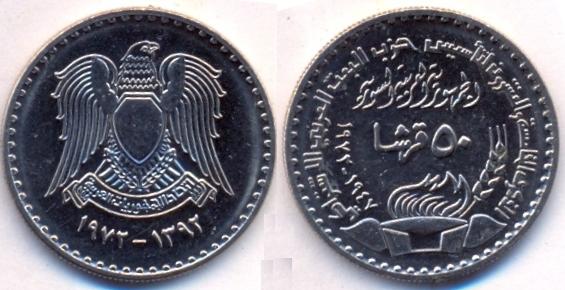 |
KM#102
50 piastres. Year:
1972 - AH 1392.
Weight: 4.98g [5.00g].
Metal:
Nickel. Diameter:
23.75 mm. Edge:
Reeded.
Alignment: Coin.
Mint: N/A.
Obverse:
Imperial eagle; Coat of arms. Dates at the bottom.
Reverse:
"celebrating 25th anniversary of
Al-Ba'ath party" at the top. Value in the center with
"الجمهورية العربية السورية" (Al-Jumhūriyyah
Al-Arabīyah As-Sūriyyah) written
above it. Years: 1947-1972 written on the left side of the flame.
Flaming torch at the bottom.
Mintage:
N/A.
Minted Years:
One year type. |
|
 |
KM#103
1 Pound. Year:
1972 - AH 1392.
Weight: 7.50g [7.50g].
Metal:
Nickel. Diameter:
27.00 mm. Edge:
Reeded.
Alignment: Coin.
Mint: N/A.
Obverse:
Imperial eagle; Coat of arms. Dates at the bottom.
Reverse:
"الجمهورية العربية السورية" (Al-Jumhūriyyah
Al-Arabīyah As-Sūriyyah) written
at the top. Arab countries map with flaming torch and value in the
center. "celebrating 25th anniversary of Al-Ba'ath party" at the bottom.
Mintage:
10,000,000.
Minted Years:
One year type. |
|
|
|
|
1973 - AH 1393 |
|
|
|
 |
KM#104
2½ piastres. Year:
1973 - AH 1393.
Weight: 2.01g [2.00g].
Metal:
Aluminum-Bronze. Diameter:
17.00 mm. Edge:
Reeded.
Alignment:
Coin.
Mint: N/A.
Obverse:
Imperial eagle; Coat of arms of Syria.
Dates at the bottom.
Reverse:
"الجمهورية العربية السورية" (Al-Jumhūriyyah
Al-Arabīyah As-Sūriyyah) written at the top.
Numeric value "2½" written below it.
Value inscription in Arabic written in the rectangle box. Design at the
bottom. Mintage:
10,000,000.
Minted Years:
One year type. |
|
|
|
|
1974 - AH 1394 |
|
|
|
 |
KM#105
5 piastres. Year:
1974 - AH 1394.
Weight: 3.01g [3.00g].
Metal:
Aluminum-Bronze. Diameter:
19.00 mm. Edge:
Reeded.
Alignment: Medal.
Mint: N/A.
Obverse:
Imperial eagle; Coat of arms of Syria.
Dates at the bottom.
Reverse:
Value within
diamond shape above design. Star on both sides.
"الجمهورية العربية السورية" (Al-Jumhūriyyah
Al-Arabīyah As-Sūriyyah)
written at the bottom. Mintage:
N/A.
Minted Years:
One year type. |
|
 |
Same as above coin, but...
Weight: 2.86g [3.00g].
This coin has less segments / reeded
line on the edge (thickness). |
|
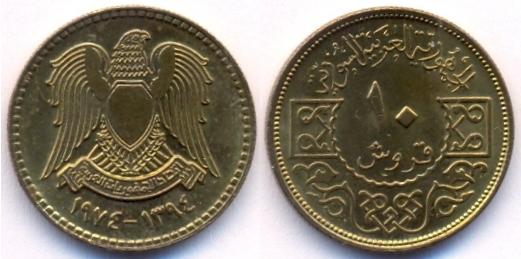 |
KM#106
10 piastres. Year:
1974 - AH 1394.
Weight: 4.07g [4.00g].
Metal:
Aluminum-Bronze. Diameter:
21.00 mm. Edge:
Reeded.
Alignment: Medal.
Mint: N/A.
Obverse:
Imperial eagle; Coat of arms of Syria.
Dates at the bottom.
Reverse:
"الجمهورية العربية السورية" (Al-Jumhūriyyah
Al-Arabīyah As-Sūriyyah) written at the top.
Value in the center surrounded by three sided
design. Mintage:
22,000,000.
Minted Years:
One year type. |
|
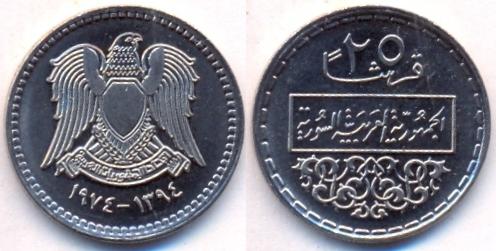 |
KM#107
25 piastres. Year:
1974 - AH 1394.
Weight: 3.31g [3.35g].
Metal:
Nickel. Diameter:
19.75 mm. Edge:
Reeded.
Alignment: Coin.
Mint: N/A.
Obverse:
Value written on top. "الجمهورية العربية السورية" (Al-Jumhūriyyah
Al-Arabīyah As-Sūriyyah) written
within the rectangular box in the center. Design at the bottom.
Reverse:
Imperial eagle; Coat of arms. Dates
at the bottom.
Mintage:
N/A.
Minted Years:
One year type. |
|
 |
KM#108
50 piastres. Year:
1974 - AH 1394.
Weight: 5.01g [5.00g].
Metal:
Nickel. Diameter:
23.75 mm. Edge:
Reeded.
Alignment: Coin.
Mint: N/A.
Obverse:
Imperial eagle; Coat of arms. Dates at the bottom.
Reverse:
"الجمهورية العربية السورية" (Al-Jumhūriyyah
Al-Arabīyah As-Sūriyyah) written
at the top. Value within the rectangular box in the center with design
above it. Sprigs at the bottom.
Mintage:
N/A.
Minted Years:
One year type. |
|
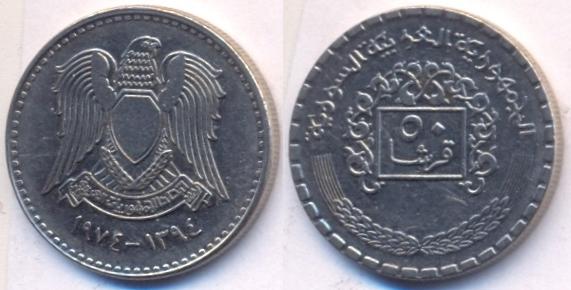 |
Same design and weight as above coin, but... This coin has less segments / reeded
line on the edge (thickness). |
|
 |
KM#109
1 Pound. Year:
1974 - AH 1394.
Weight: 7.43g [7.50g].
Metal:
Nickel. Diameter:
27.00 mm. Edge:
Reeded.
Alignment: Coin.
Mint: N/A.
Obverse:
Imperial eagle; Coat of arms. Dates at the bottom.
Reverse:
"الجمهورية العربية السورية" (Al-Jumhūriyyah
Al-Arabīyah As-Sūriyyah) written
at the top. Value in diamond at center of rectangular box in the center.
Mintage:
N/A.
Minted Years:
One year type. |
|
|
|
|
1976 - AH 1396
- Euphrates Dam issues. |
|
|
|
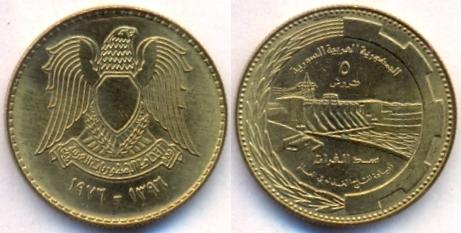 |
KM#110
5 piastres. Year:
1976 - AH 1396.
Weight: 2.99g [3.00g].
Metal:
Aluminum-Bronze. Diameter:
19.00 mm. Edge:
Reeded.
Alignment: Medal.
Mint: N/A.
Obverse:
Imperial eagle; Coat of arms of Syria.
Dates at the bottom.
Reverse:
Euphrates dam with 1/2
gear and 1/2 oat sprig.
"الجمهورية العربية السورية" (Al-Jumhūriyyah
Al-Arabīyah As-Sūriyyah)
and value above the dam. Mintage:
2,000,000.
Minted Years:
One year type. |
|
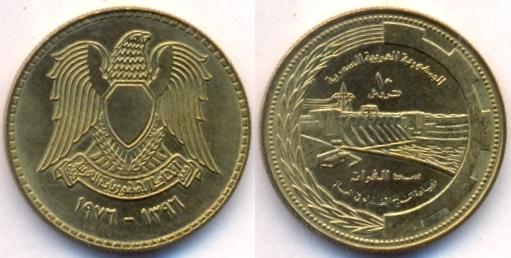 |
KM#111
10 piastres. Year:
1976 - AH 1396.
Weight: 4.00g [4.00g].
Metal:
Aluminum-Bronze. Diameter:
21.00 mm. Edge:
Reeded.
Alignment: Medal.
Mint: N/A.
Obverse:
Imperial eagle; Coat of arms of Syria.
Dates at the bottom.
Reverse:
Euphrates dam with 1/2
gear and 1/2 oat sprig.
"الجمهورية العربية السورية" (Al-Jumhūriyyah
Al-Arabīyah As-Sūriyyah)
and value above the dam. Mintage:
500,000.
Minted Years:
One year type. |
|
 |
KM#112
25 piastres. Year:
1976 - AH 1396.
Weight: 3.34g [3.35g].
Metal:
Nickel. Diameter:
19.75 mm. Edge:
Reeded.
Alignment: Medal.
Mint: N/A.
Obverse:
Imperial eagle; Coat of arms. Dates
at the bottom.
Reverse:
Euphrates dam with 1/2
gear and 1/2 oat sprig.
"الجمهورية العربية السورية" (Al-Jumhūriyyah
Al-Arabīyah As-Sūriyyah)
and value above the dam.
Mintage:
1,000,000.
Minted Years:
One year type. |
|
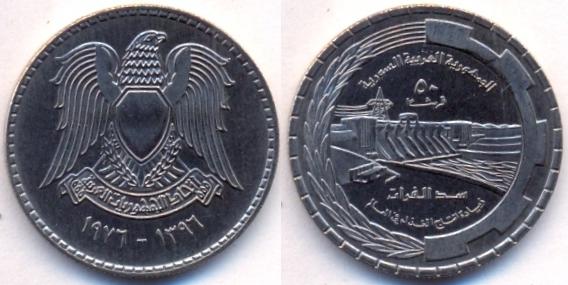 |
KM#113
50 piastres. Year:
1976 - AH 1396.
Weight: 5.04g [5.00g].
Metal:
Nickel. Diameter:
23.75 mm. Edge:
Reeded.
Alignment: Medal.
Mint: N/A.
Obverse:
Imperial eagle; Coat of arms. Dates
at the bottom.
Reverse:
Euphrates dam with 1/2
gear and 1/2 oat sprig.
"الجمهورية العربية السورية" (Al-Jumhūriyyah
Al-Arabīyah As-Sūriyyah)
and value above the dam.
Mintage:
1,000,000.
Minted Years:
One year type. |
|
 |
KM#114
1 Pound. Year:
1976 - AH 1396.
Weight: 7.43g [7.50g].
Metal:
Nickel. Diameter:
27.00 mm. Edge:
Reeded.
Alignment: Medal.
Mint: N/A.
Obverse:
Imperial eagle; Coat of arms. Dates at the bottom.
Reverse:
Euphrates dam with 1/2
gear and 1/2 oat sprig.
"الجمهورية العربية السورية" (Al-Jumhūriyyah
Al-Arabīyah As-Sūriyyah)
and value above the dam.
Mintage:
500,000.
Minted Years:
One year type. |
|
|
|
|
1978 - AH 1398 |
|
Imperial eagle; Coat of arms of Syria with three stars in the
center from 1978 to 1991. |
|
|
|
 |
KM#115
1 Pound. Year:
1978 - AH 1398.
Weight: 7.52g [7.50g].
Metal:
Nickel. Diameter:
27.00 mm. Edge:
Reeded.
Alignment: Medal.
Mint: N/A.
Obverse:
Portrait of Hafez al-Assad facing left in center circle. Dates on
both sides outside the circle. "Winning the re-election for Presidency".
Reverse:
"الجمهورية العربية السورية" (Al-Jumhūriyyah
Al-Arabīyah As-Sūriyyah)
at the top and value below; outside the circle.
Imperial eagle; Coat of arms in center circle.
Mintage:
N/A.
Minted Years:
One year type. |
|
|
|
|
1979 - AH 1399 |
|
|
|
 |
KM#116
5 piastres. Year:
1979 - AH 1399.
Weight: 2.96g [3.00g].
Metal:
Aluminum-Bronze. Diameter:
19.00 mm. Edge:
Reeded.
Alignment: Medal.
Mint: N/A.
Obverse:
Imperial eagle; Coat of arms of Syria.
Dates at the bottom.
Reverse:
Value within
diamond shape above design. Star on both sides.
"الجمهورية العربية السورية" (Al-Jumhūriyyah
Al-Arabīyah As-Sūriyyah)
written at the bottom. Mintage:
N/A.
Minted Years:
One year type. |
|
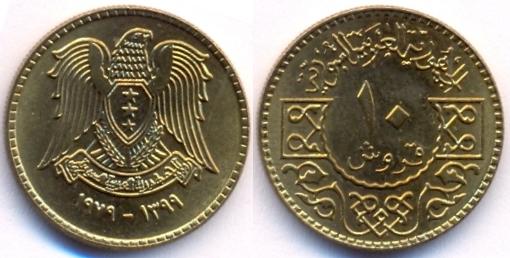 |
KM#117
10 piastres. Year:
1979 - AH 1399.
Weight: 3.97g [4.00g].
Metal:
Aluminum-Bronze. Diameter:
21.00 mm. Edge:
Reeded.
Alignment: Medal.
Mint: N/A.
Obverse:
Imperial eagle; Coat of arms of Syria.
Dates at the bottom.
Reverse:
"الجمهورية العربية السورية" (Al-Jumhūriyyah
Al-Arabīyah As-Sūriyyah) written at the top.
Value in the center surrounded by three sided
design. Mintage:
N/A.
Minted Years:
One year type. |
|
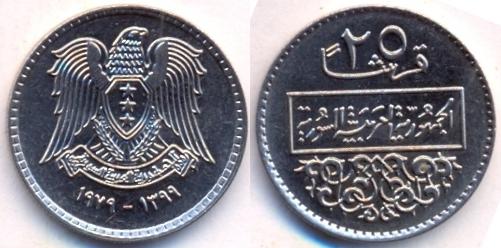 |
KM#118
25 piastres. Year:
1979 - AH 1399.
Weight: 3.31g [3.35g].
Metal:
Copper-Nickel. Diameter:
19.75 mm. Edge:
Reeded.
Alignment: Medal.
Mint: N/A.
Obverse:
Value written on top. "الجمهورية العربية السورية" (Al-Jumhūriyyah
Al-Arabīyah As-Sūriyyah) written
within the rectangular box in the center. Design at the bottom.
Reverse:
Imperial eagle; Coat of arms. Dates
at the bottom.
Mintage:
N/A.
Minted Years:
One year type. |
|
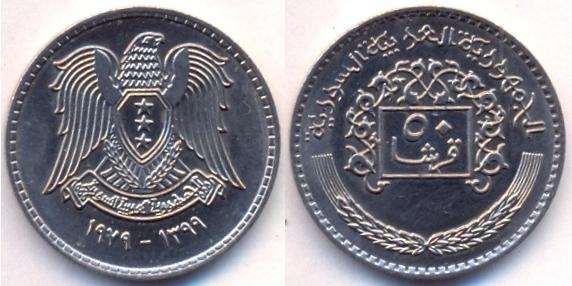 |
KM#119
50 piastres. Year:
1979 - AH 1399.
Weight: 4.98g [5.00g].
Metal:
Copper-Nickel. Diameter:
23.75 mm. Edge:
Reeded.
Alignment: Medal.
Mint: N/A.
Obverse:
Imperial eagle; Coat of arms. Dates at the bottom.
Reverse:
"الجمهورية العربية السورية" (Al-Jumhūriyyah
Al-Arabīyah As-Sūriyyah) written
at the top. Value within the rectangular box in the center with design
above it. Sprigs at the bottom.
Mintage:
N/A.
Minted Years:
One year type. |
|
 |
KM#120.1
1 Pound. Year:
1979 - AH 1399.
Weight: 7.58g [7.50g].
Metal:
Copper-Nickel. Diameter:
27.00 mm. Edge:
Reeded.
Alignment: Medal.
Mint: N/A.
Obverse:
Imperial eagle; Coat of arms. Dates at the bottom.
Reverse:
"الجمهورية العربية السورية" (Al-Jumhūriyyah
Al-Arabīyah As-Sūriyyah) written
at the top. Value in diamond at center of rectangular box in the center.
Mintage:
N/A.
Minted Years:
One year type. |
|
|
|
|
1991 - AH 1412 |
|
|
|
 |
KM#120.2
1 Pound. Year:
1991 - AH 1412.
Weight: 5.05g [5.00g].
Metal: Stainless
Steel. Diameter:
25.50 mm. Edge:
Reeded.
Alignment: Medal.
Mint: N/A.
Obverse:
Imperial eagle; Coat of arms. Dates at the bottom.
Reverse:
"الجمهورية العربية السورية" (Al-Jumhūriyyah
Al-Arabīyah As-Sūriyyah) written
at the top. Value in diamond at center of rectangular box in the center.
Mintage:
N/A.
Minted Years:
One year type. |
|
|
|
|
1994 - AH 1414 |
|
Imperial eagle; Coat of arms of Syria with two stars in the center
from 1994 onwards. |
|
|
|
 |
KM#121
1 Pound. Year:
1994 - AH 1414.
Weight: 5.04g [5.00g].
Metal: Stainless
Steel. Diameter:
25.50 mm. Edge:
Reeded.
Alignment: Medal.
Mint: N/A.
Obverse:
Imperial eagle; Coat of arms. Dates at the bottom.
Reverse:
"الجمهورية العربية السورية" (Al-Jumhūriyyah
Al-Arabīyah As-Sūriyyah) written
at the top. Value in diamond at center of rectangular box in the center.
Mintage:
N/A.
Minted Years:
One year type. |
|
|
|
|
ND (1995 - AH 1416) |
|
|
|
.jpg) |
KM#122
25 Pounds. Year:
ND (1995 - AH 1416).
Weight: 6.45g [6.45g].
Metal:
Bi-metallic; Stainless Steel in center and Aluminum-Bronze ring. Diameter:
25.00 mm. Edge:
Reeded.
Alignment: Medal.
Mint: N/A.
Obverse:
Imperial eagle; Coat of arms and Dates 1970-1995 (left) and
1370-1416 (right) at the bottom, within center circle.
"الجمهورية العربية السورية" (Al-Jumhūriyyah
Al-Arabīyah As-Sūriyyah) written
at the top. Value in words at the bottom.
Reverse:
Portrait of Hafez al-Assad facing left in center circle. Arabic
legends around outer circle.
Mintage:
N/A.
Minted Years:
One year type. |
|
|
|
|
1996 - AH 1416 |
|
The shape of the 10
Syrian pound coin has been found to so resemble the 20 Norwegian Krone coin that
it can fool vending machines, coins-to-cash machines, arcade machines, and any
other coin-operated, automated service machine in the country. While hardly
similar to the naked eye, machines are unable to tell the coins apart due to an
almost identical weight and size. As of November 23, 2007, ten Syrian pounds
converts to 1.07 Norwegian kroner, or about 0.20 United States dollar. 20 NOK,
on the other hand, converts to 3.70 USD, almost 18.6 times the value of the
Syrian coin. While not easy to find in Norway, the Syrian coins are still used
in automated machines there with such frequency that Posten Norge, the Norwegian
postal service, decided to close many of their coins-to-cash machines on
February 18, 2006, with plans to develop a system able to differentiate between
the two coins. In the summer of 2005, a Norwegian man was sentenced to 30 days,
suspended, for having used Syrian coins in arcade machines in the municipality
of Bærum. |
|
|
|
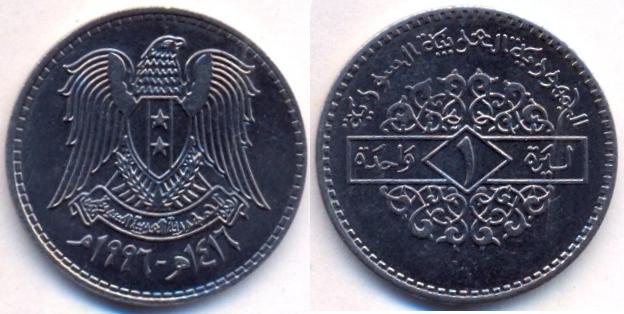 |
KM#132
1 Pound. Year:
1996 - AH 1416.
Weight: 5.00g [5.00g].
Metal: Stainless
Steel. Diameter:
25.50 mm. Edge:
Reeded.
Alignment: Medal.
Mint: N/A.
Obverse:
Imperial eagle; Coat of arms. Dates at the bottom.
Reverse:
"الجمهورية العربية السورية" (Al-Jumhūriyyah
Al-Arabīyah As-Sūriyyah) written
at the top. Value in diamond at center of rectangular box in the center.
Mintage:
N/A.
Minted Years:
One year type. |
|
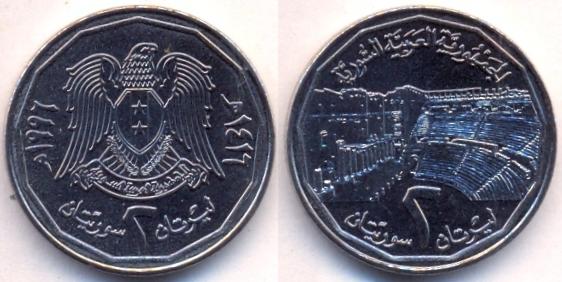 |
KM#125
2 Pounds. Year:
1996 - AH 1416.
Weight: 5.98g [6.00g].
Metal: Stainless
Steel. Diameter:
23.00 mm. Edge:
Reeded.
Alignment: Medal.
Mint: N/A.
Obverse:
Imperial eagle; Coat of arms. Dates at both sides. Value at the bottom.
Reverse:
"الجمهورية العربية السورية" (Al-Jumhūriyyah
Al-Arabīyah As-Sūriyyah) written
at the top. Ancient ruins in the center. Value at the bottom.
Mintage:
N/A.
Minted Years:
One year type. |
|
 |
KM#123
5 Pounds. Year:
1996 - AH 1416.
Weight: 5.03g [5.00g].
Metal:
Copper-Nickel. Diameter:
24.50 mm. Edge:
Reeded.
Alignment: Medal.
Mint: N/A.
Obverse:
Imperial eagle; Coat of arms. Dates at the bottom.
Reverse:
"الجمهورية العربية السورية" (Al-Jumhūriyyah
Al-Arabīyah As-Sūriyyah) written
at the top. Palace in the center. Value at the bottom.
Mintage:
N/A.
Minted Years:
One year type. |
|
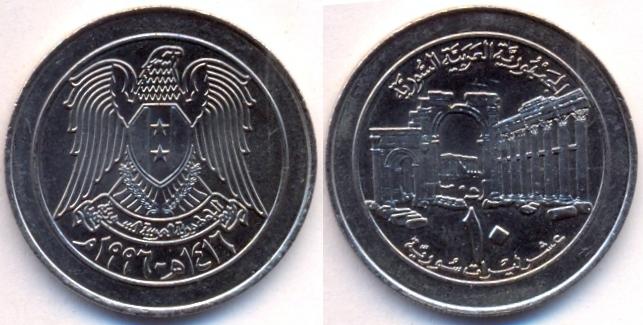 |
KM#124
10 Pounds. Year:
1996 - AH 1416.
Weight: 7.00g [7.00g].
Metal:
Copper-Nickel. Diameter:
26.50 mm. Edge:
Reeded.
Alignment: Medal.
Mint: N/A.
Obverse:
Imperial eagle; Coat of arms. Dates at the bottom.
Reverse:
"الجمهورية العربية السورية" (Al-Jumhūriyyah
Al-Arabīyah As-Sūriyyah) written
at the top. Ancient ruins in the center. Value at the bottom.
Mintage:
N/A.
Minted Years:
One year type. |
|
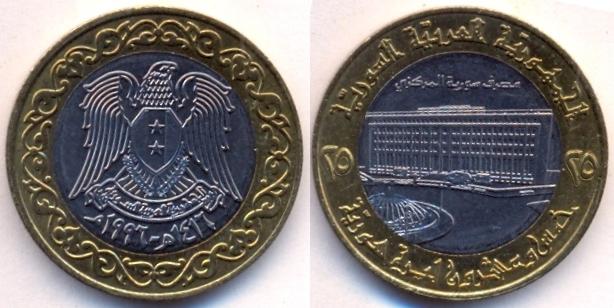 |
KM#126
25 Pounds. Year:
1996 - AH 1416.
Weight: 6.45g [6.45g].
Metal:
Bi-metallic; Stainless Steel in center and Aluminum-Bronze ring. Diameter:
25.00 mm. Edge:
Reeded.
Alignment: Medal.
Mint: N/A.
Obverse:
Imperial eagle; Coat of arms. Dates at the bottom. Design in the
outer circle.
Reverse:
"الجمهورية العربية السورية" (Al-Jumhūriyyah
Al-Arabīyah As-Sūriyyah) written
at the top. Central Bank building in the center. "25" written on both
sides. Value in words at the bottom.
Mintage:
N/A.
Minted Years:
One year type. |
|
|
|
|
1997 - AH 1417 |
|
|
|
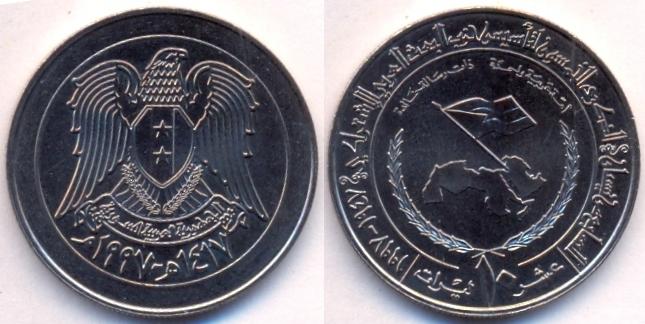 |
KM#128
10 Pounds. Year:
1997 - AH 1417.
Weight: 6.98g [7.00g].
Metal:
Copper-Nickel. Diameter:
26.50 mm. Edge:
Reeded.
Alignment: Medal.
Mint: N/A.
Obverse:
Imperial eagle; Coat of arms. Dates at the bottom.
Reverse:
Arab map with flag above sprigs. 50th
Anniversary of Al-Ba'ath party 1947-1997. Value at the bottom.
Mintage:
100,000.
Minted Years:
One year type. |
|
|
|
|
2003 - AH 1424 |
|
The standard abbreviation for the Syrian pound is SYP. On
05 December 2005, the selling rate quoted by the Commercial Bank of Syria was
58.4 SYP to the US dollar. A rate of about 50 pounds to one US Dollar. has been
usual in the early 2000s, but the exchange rate is subject to fluctuations. During the Syrian Uprising against the president Bashar Al Assad,
the exchange rate of Syrian Pound has deteriorated quickly from 47 SYP to One USD
in March 2011 to over 100 SYP to One USD in March 2012. Hard currencies such as
the USD, CAD, GBP or Euro cannot be bought from banks or exchange companies. The
Black Market is the only source of foreign currencies to Syrian businessmen. Students and those who want to travel abroad,
maximum amount that is allowed to
be taken out with the Syrian traveler is 3,000 USD per flight per year. Any
amount in excess of 3,000 USD is confiscated by the authorities and the Syrian
traveler will risk spending a long time in the what is called "economic affairs
court". The Syrian Pound is not a hard currency, and there are restrictions on
its export (maximum amount is 2,500 SYP per person). |
|
|
|
 |
KM#129
5 Pounds. Year:
2003 - AH 1424.
Weight: 7.48g [7.50g].
Metal:
Copper-Nickel. Diameter:
24.50 mm. Edge:
Reeded and lettering.
Alignment: Medal.
Mint: N/A.
Obverse:
Imperial eagle; Coat of arms. Dates at the bottom.
Reverse:
"الجمهورية العربية السورية" (Al-Jumhūriyyah
Al-Arabīyah As-Sūriyyah) written
at the top. Palace in the center. Value at the bottom.
Hologram circle displays
"CBS" or "5" by changing angles. Mintage:
N/A.
Minted Years:
One year type. |
|
Note: If the
Imperial eagle side is on the top, the edge lettering is readable as
"CENTRAL BANK 5 SYP *" |
|
 |
Same as above coin, but...
Weight: 7.56g [7.50g]
Note:
If the
Imperial eagle side is on the top, the edge lettering is inverted /
upside down. |
|
 |
KM#130
10 Pounds. Year:
2003 - AH 1424.
Weight: 9.68g [9.50g].
Metal:
Nickel-Brass. Diameter:
27.00 mm. Edge:
Reeded and lettering.
Alignment: Medal.
Mint: N/A.
Obverse:
Imperial eagle; Coat of arms. Dates at the bottom.
Reverse:
"الجمهورية العربية السورية" (Al-Jumhūriyyah
Al-Arabīyah As-Sūriyyah) written
at the top. Ancient ruins in the center. Value at the bottom.
Hologram gate displays
"CBS" or "10" by changing angles. Mintage:
N/A.
Minted Years:
One year type. |
|
Note: If the
Imperial eagle side is on the top, the edge lettering is readable as
"10 SYRIAN POUNDS *" |
|
 |
Same as above coin, but...
Weight: 9.52g [9.50g]
Note:
If the
Imperial eagle side is on the top, the edge lettering is inverted /
upside down. |
|
 |
KM#131
25 Pounds. Year:
2003 - AH 1424.
Weight: 8.41g [8.45g].
Metal:
Bi-metallic; Copper-Nickel in center and Nickel-Brass ring. Diameter:
25.00 mm. Edge:
Reeded.
Alignment: Medal.
Mint: N/A.
Obverse:
Imperial eagle; Coat of arms. Dates at the bottom.
"الجمهورية العربية السورية" (Al-Jumhūriyyah
Al-Arabīyah As-Sūriyyah) written
at the top. Value in words at the bottom. |
|
Reverse:
"SYRIAN ARAB REPUBLIC" on the top. "25" written on both sides.
Central Bank building in the center circle.
Hologram circle displays
"CBS" or "25" by changing angles. "TWENTY FIVE SYRIAN POUNDS" written at
the bottom.
Mintage:
N/A.
Minted Years:
One year type.
Note: If the
Imperial eagle side is on the top, the edge lettering is readable as
"CENTRAL BANK OF SYRIA 25 *" |
|
 |
Same as above coin, but...
Weight: 8.42g [8.45g]
Note:
If the
Imperial eagle side is on the top, the edge lettering is inverted /
upside down. |
|
|
|
|
2018 - AH 1439 |
|
|
|
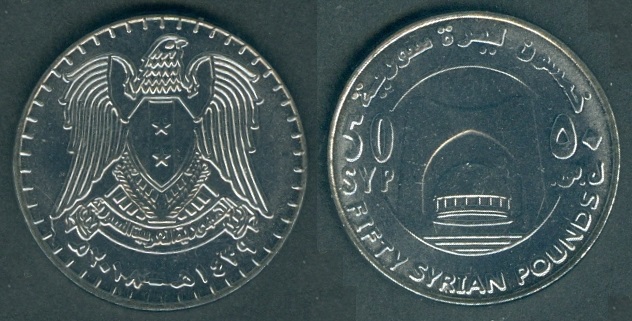 |
KM#133
50 Pounds. Year:
2018 - AH 1439.
Weight: 7.41g [7.40g].
Metal:
Nickel plated Steel. Diameter:
25.00 mm. Edge:
Reeded.
Alignment: Medal.
Mint: N/A.
Obverse:
Imperial eagle; Coat of arms in the center.
"الجمهورية العربية السورية" (Al-Jumhūriyyah
Al-Arabīyah As-Sūriyyah) [Syrian
Arab Republic] written
within the banner of the Coat of arms.
Dates "١٤٣٩هـ - ٢٠١٨مـ" at the bottom (2018 M - 1439 H). |
|
Reverse:
"خمسون ليرة سورية"
(Fifty Liras of Syria) written in Arabic at the top. Tomb of the Unknown
Soldier in the center. "50" written on the left side with "SYP"
written below it. "٥٠" (50) written at the left side with "ل.س." (L.S. =
Liras of Syrian) written below it. "FIFTY SYRIAN POUNDS" written at
the bottom.
Mintage:
N/A.
Minted Years:
One year type.
|
|
|
|
|
|
- General Military Governor of Occupied Enemy
Territory Administration - East
- Ali Rida Pasha ar-Rikabi...........................03
Oct 1918 - 10 Dec 1919 d. 1943
- Deputy Military Governors
- Abdul Hamid Pasha al-Qaltaqji......................10
Dec 1919 - 14 Dec 1919
- Mustafa Ni'mat.....................................14
Dec 1919 - 26 Jan 1920
- Chief of the Council of Directors
- Zaid bin al-Hussein al-Hashimi.....................26
Jan 1920 - 09 Mar 1920 d. 1970
- Prime ministers
- Ali Rida Pasha ar-Rikabi...........................09
Mar 1920 - 03 May 1920 d. 1942
- Muhammad Hashim Bey bin Muhammad
Khalid al-Atassi..03 May 1920 - 28 Jul 1920 d. 1960
- Served as 1st time.
- Ala ad-Din ad-Durubi Basha.........................28
Jul 1920 - 21 Aug 1920
- Vacant: 21 Aug 1920 - 06 Sep 1920.
- Muhammad Jamil Bey al-Ulshi (1st
time).............06 Sep 1920 - 30 Nov 1920 d. 1951
- Post abolished: 30 Nov 1920 - 26 Jan
1925.
- Subhi Bey Barakat al-Khalidi.......................26
Jan 1925 - 21 Dec 1925 d. 1939
- Muhammad Taj ad-Din (acting
- 1st time)............29 Dec 1925 - 06 Jan 1926 d. 1943
- Full name:
al-Sheikh Muhammad Taj ad-Din bin Badr al-Din al-Hasani.
- Vacant: 06 Jan 1926 - 27 Apr 1926.
- al-Damad Ahmad Nami Bey bin Fakhri
Bey.............27 Apr 1926 - 09 Feb 1928
- Muhammad Taj ad-Din (2nd
time).....................14 Feb 1928 - 19 Nov 1931
- Vacant: 19
Nov 1931 - 07 Jun 1932.
- Haqqi Bey al-Azm...................................07
Jun 1932 - 16 Mar 1934 d. 1955
- Muhammad Taj ad-Din (3rd
time).....................16 Mar 1934 - 22 Feb 1936
- Ata Bey bin Muhammad Ali al-Ayyubi
(1st time)......22 Feb 1936 - 21 Dec 1936
d. 1951
- Jamil Mardam Bey (1st
time)........................21 Dec 1936 - 18 Feb 1939 d. 1960
- Lutfi al-Haffar....................................23
Feb 1939 - 05 Apr 1939 d. 1968
- Nasuhi Salim al-Bukhari............................06
Apr 1939 - 08 Jul 1939 d. 1961
- President of the council of Directors General
- Bahij Bey al-Khatib................................08
Jul 1939 - 02 Apr 1941 d. 1981
- Prime ministers
- Khalid bin
Muhammad Fawzi al-Azm (1st
time)........02
Apr 1941 - 21 Sep 1941 d. 1965
- Hassan al-Hakim (1st
time).........................21
Sep 1941 - 19 Apr 1942 d. 1982
- Husni al-Barazi....................................19
Apr 1942 - 10 Jan 1943 d. 1975
- Muhammad Jamil Bey
al-Ulshi (2nd
time).............10
Jan 1943 - 25 Mar 1943
- Ata Bey bin
Muhammad Ali al-Ayyubi (2nd
time)......25
Mar 1943 - 17 Aug 1943
- Saadallah al-Jabiri
(1st time).....................19
Aug 1943 - 14 Oct 1944 d. 1947
- Faris al-Khuri (1st
time)..........................14
Oct 1944 - 01 Oct 1945 d. 1962
- Saadallah al-Jabiri
(2nd time).....................01
Oct 1945 - 16 Dec 1946
- Khalid bin
Muhammad Fawzi al-Azm (acting
2nd time).16
Dec 1946 - 29 Dec 1946
- Jamil Mardam Bey (2nd
time)........................29
Dec 1946 - 17 Dec 1948
- Khalid bin
Muhammad Fawzi al-Azm (3rd
time)........17
Dec 1948 - 30 Mar 1949
- Husni al-Zaim......................................17
Apr 1949 - 26 Jun 1949 d. 1949
- Muhsin al-Barazi...................................26
Jun 1949 - 14 Aug 1949 d. 1949
- Muhammad Hashim
Bey bin Muhammad Khalid al-Atassi..17 Aug 1949 - 24 Dec 1949
- Served as 2nd time.
- Nazim al-Kudsi (1st
time)..........................24
Dec 1949 - 27 Dec 1949 d. 1998
- Khalid bin
Muhammad Fawzi al-(4th
time)............27
Dec 1949 - 04 Jun 1950
- Nazim al-Kudsi (2nd
time)..........................04
Jun 1950 - 27 Mar 1951
- Khalid bin
Muhammad Fawzi al-Azm (5th
time)........27
Mar 1951 - 09 Aug 1951
- Hassan al-Hakim (2nd
time).........................09
Aug 1951 - 13 Nov 1951
- Zaki al-Khatib (acting)............................13
Nov 1951 - 28 Nov 1951 d. 1961
- Maaruf ad-Dawalibi
(1st time)......................28
Nov 1951 - 29 Nov 1951 d. 2004
- Fawzi Silu.........................................03
Dec 1951 - 19 Jul 1953 d. 1972
- He was Head of State: 03 Dec 1951 - 11 Jul
1953.
- Adib al-Shishakli..................................19
Jul 1953 - 01 Mar 1954 d. 1964
- Served twice briefly as President of Syria: 02
Dec 1951 - 03 Dec 1951 (chairman Supreme Military Council) and 11 Jul
1953 - 25 Feb 1954.
- Sabri al-Assali (1st
time).........................01
Mar 1954 - 18 Jun 1954 d. 1976
- Said al-Ghazzi (1st
time)..........................18
Jun 1954 - 03 Nov 1954 d. 1967
- Faris al-Khuri (2nd
time)..........................03
Nov 1954 - 13 Feb 1955
- Sabri al-Assali (2nd
time).........................13
Feb 1955 - 13 Sep 1955
- Said al-Ghazzi (2nd
time)..........................13
Sep 1955 - 14 Jun 1956
- Sabri al-Assali (3rd
time).........................14
Jun 1956 - 06 Mar 1958
- Chairmen of the Executive Council
of the Syrian Region (United Arab Republic)
- Nureddin Kahala....................................07
Oct 1958 - 20 Sep 1960 d. 1965
- Abdul Hamid Serraj.................................20
Sep 1960 - 16 Aug 1961 d. 2013
- Prime ministers
- Maamun al-Kuzbari..................................28
Sep 1961 - 20 Nov 1961 d. 1998
- Served twice briefly as President of Syria: 26
Feb 1954 - 28 Feb 1954 and 29 Sep 1961 - 20 Nov 1961.
- Izzat al-Nuss......................................20
Nov 1961 - 14 Dec 1961
- Maaruf ad-Dawalibi
(2nd time)......................22
Dec 1961 - 28 Mar 1962
- Ahmad Bashir al-Azmah..............................16
Apr 1962 - 14 Sep 1962 d. 1992
- Khalid bin
Muhammad Fawzi al-Azm (6th
time)........17
Sep 1962 - 09 Mar 1963
- Salah ad-Din Bitar
(1st time)......................09
Mar 1963 - 12 Nov 1963 d. 1980
- Muhammad Amin
al-Hafez (1st
time)..................12
Nov 1963 - 13 May 1964 d. 2009
- Salah ad-Din Bitar
(2nd time)......................13
May 1964 - 03 Oct 1964
- Muhammad Amin
al-Hafez (2nd
time)..................04
Oct 1964 - 23 Sep 1965
- Yusuf Zuaiyin (1st
time)...........................23
Sep 1965 - 21 Dec 1965 d. 2016
- Salah ad-Din Bitar
(3rd time)......................01
Jan 1966 - 23 Feb 1966
- Yusuf Zuaiyin (2nd
time)...........................25
Feb 1966 - 29 Oct 1968
- Ahmad Nureddin bin
Muhammad Ali al-Atassi..........29 Oct 1968 - 21 Nov 1970 d. 1992
- Hafez Ali Sulayman
al-Assad........................21 Nov 1970 - 03 Apr 1971 d. 2000
- Abdul Rahman
Khleifawi (1st
time)..................03
Apr 1971 - 21 Dec 1972 d. 2009
- Mahmoud al-Ayyubi..................................21
Dec 1972 - 07 Aug 1976 d. 2013
- Abdul Rahman
Khleifawi (2nd
time)..................07
Aug 1976 - 27 Mar 1978
- Muhammad Ali al-Halabi.............................27
Mar 1978 - 09 Jan 1980 d. 2016
- Abdul Rauf al-Kasm.................................09
Jan 1980 - 01 Nov 1987
- Mahmoud Zuabi......................................01
Nov 1987 - 13 Mar 2000 d. 2000
- Muhammed Mustafa
Mero..............................13 Mar 2000 - 10 Sep 2003
- Muhammad Naji al-Otari.............................10
Sep 2003 - 14 Apr 2011
- Adel
Safar.........................................14 Apr 2011 - 23 Jun 2012
- Riyad Farid Hijab..................................23
Jun 2012 - 06 Aug 2012
- Omar Ibrahim
Ghalawanji (acting)...................06
Aug 2012 - 11 Aug 2012
- Wael Nader al-Halqi................................11
Aug 2012 - 03 Jul 2016
- Interim prime ministers, in rebellion
- Ghassan Hitto.................................19
Mar 2013 - 08 Jul 2013
- Ahmad Saleh Touma.............................14
Sep 2013 - 16 May 2016
- Jawad Abu Hatab...............................16
May 2016 - 10 Mar 2019
- Imad Muhammed
Khamis...............................03 Jul 2016 - 11 Jun 2020
- Hussein Arnous.....................................11
Jun 2020 - date
- He was acting to 02 September 2020.
|
|
|
|
|
|
|
|
|
|
|
|
|
|
|
|
|
|
|
|
|
|
|
|
|
|
|
|
|
|
|
|
|
|
|
|
|
|
|
| Countries
/ Territories |
| |
|
Chiefa Coins | |
|


































































































.jpg)












